The landslide problem
G. Shanmugam
Department of Earth and Environmental Sciences, The University of Texas at Arlington, Arlington, TX 76019, USA
Abstract The synonymous use of the general term “l(fā)andslide”, with a built-in reference to a sliding motion, for all varieties of mass-transport deposits (MTD), which include slides,slumps, debrites, topples, creeps, debris avalanches etc. in subaerial, sublacustrine, submarine, and extraterrestrial environments has created a multitude of conceptual and nomenclatural problems. In addition, concepts of triggers and long-runout mechanisms of mass movements are loosely applied without rigor. These problems have enormous implications for studies in process sedimentology, sequence stratigraphy, palaeogeography, petroleum geology, and engineering geology. Therefore, the objective of this critical review is to identify key problems and to provide conceptual clarity and possible solutions. Specific issues are the following: (1) According to “l(fā)imit equilibrium analyses” in soil mechanics, sediment failure with a sliding motion is initiated over a shear surface when the factor of safety for slope stability (F) is less than 1. However, the term landslide is not meaningful for debris flows with a flowing motion. (2) Sliding motion can be measured in oriented core and outcrop, but such measurement is not practical on seismic profiles or radar images. (3) Although 79 MTD types exist in the geological and engineering literature, only slides, slumps, and debrites are viable depositional facies for interpreting ancient stratigraphic records. (4) The use of the term landslide for highvelocity debris avalanches is inappropriate because velocities of mass-transport processes cannot be determined in the rock record. (5) Of the 21 potential triggering mechanisms of sediment failures, frequent short-term events that last for only a few minutes to several hours or days (e.g., earthquakes, meteorite impacts, tsunamis, tropical cyclones, etc.) are more relevant in controlling deposition of deep-water sands than sporadic long-term events that last for thousands to millions of years (e.g., sea-level lowstands). (6) The comparison of H/L(fall height/runout distance) ratios of MTD in subaerial environments with H/L ratios of MTD in submarine and extraterrestrial environments is incongruous because of differences in data sources (e.g., outcrop vs. seismic or radar images). (7) Slides represent the pre-transport disposition of strata and their reservoir quality (i.e., porosity and permeability) of the provenance region, whereas debrites reflect post-transport depositional texture and reservoir quality. However, both sandy slides and sandy debrites could generate blocky wireline (gamma-ray) log motifs. Therefore, reservoir characterization of deep-water strata must be based on direct examination of the rocks and related process-specific facies interpretations, not on wireline logs or on seismic profiles and related process-vague facies interpretations. A solution to these problems is to apply the term “l(fā)andslide” solely to cases in which a sliding motion can be empirically determined. Otherwise, a general term MTD is appropriate. This decree is not just a quibble over semantics; it is a matter of portraying the physics of mass movements accurately.A precise interpretation of a depositional facies (e.g., sandy slide vs. sandy debrite) is vital not only for maintaining conceptual clarity but also for characterizing petroleum reservoirs.
Key words debris flows, landslides, mass-transport deposits (MTD), slides, slumps, soil strength, triggering mechanisms, reservoir characterization
1 Introduction
The general term “l(fā)andslide” is very popular. A cursory Google search of the term landslide has yielded 6,100,000 results. The reason is that the topic of landslides is of inter?est to researchers in a wide range of scientific disciplines,which include sedimentology, oceanography, geomor?phology, volcanology, seismology, glaciology, areology(i.e., geology of Mars), deep?sea structural engineering,highway engineering, soil mechanics, climate change, eu?stasy, natural hazards, and petroleum exploration and pro?duction. Not surprisingly, each scientific community has arrived at its own nomenclatural scheme (Hansen, 1984).However, there is no conceptual link between different schemes on landslides. Consequently, the term landslide means different things to different populace. This concep?tual disconnect and its consequences are the primary focus of this paper.
Since the early recognition of subaerial “l(fā)andslides” in 186 BC in China (Li, 1989), their common occurrences in subaerial and submarine environments have been well documented worldwide (Figure 1). In subaerial settings,for example, fault?induced alluvial fans are dominated by mass?transport deposits (McPhersonet al., 1987).Aspects of subaerial, sublacustrine, and submarine land?slides have been reviewed adequately during the past 140 years (Baltzer, 1875; Howe, 1909; Reynolds, 1932;Ladd, 1935; Sharpe, 1938; Ward, 1945; Popov, 1946;Eckel, 1958; Yatsu, 1967; Hutchinson, 1968; Zaruba and Mencl, 1969; Blong, 1973; Crozier, 1973; Coates, 1977;Woodcock, 1979; Hansen, 1984; Varnes, 1984; Brabb and Harrod, 1989; Schwabet al., 1993; Hamptonet al., 1996;Elverh?iet al., 1997; Locat and Lee, 2000, 2002; Hungret al., 2001; Dykstra, 2005; Gladeet al., 2005; Solheimet al., 2005a; Massonet al., 2006; Shanmugam, 2009, 2012a,2013a; Moernaut and De Batist, 2011; Shippet al., 2011;Clague and Stead, 2012; Krastelet al., 2014, among oth?ers). On Earth, landslides have been recognized on bathy?metric images (Figure 2) (Greeneet al., 2006), on seis?mic profiles (Figure 3) (Solheimet al., 2005b) (Geeet al.,2006), in outcrops (Heim, 1882; Macdonaldet al., 1993),and in conventional cores (Shanmugam, 2006a, 2012a).On Mars, landslides have been interpreted using shaded?relief map of the Thaumasia Plateau (Thermal Emission Imaging System infrared [THEMIS IR]) by Montgomeryet al.(2009, their Figure 9).
1.1 Importance of mass-transport deposits (MTD)
Mass?transport deposits (MTD) are important not only because of their volumetric significance in the sedimen?tary record (Gamboaet al., 2010), but also because of their frequent impacts on human lives both socially and economically (USGS, 2010; Petley, 2012). Since the birth of modern deep?sea exploration by the voyage of H.M.S.Challenger (December 21, 1872-May 24, 1876), organ?ized by the Royal Society of London and the Royal Navy(Murray and Renard, 1891), oceanographers have made considerable progress in understanding the world’s oceans.Nevertheless, the physical processes that are responsible for transporting sediment downslope into the deep sea are still poorly understood. This is simply because the physics and hydrodynamics of these processes are difficult to observe and measure directly in deep?marine and extraterrestrial en?vironments. This observational impediment has created an enormous challenge for understanding and communicat?ing the mechanics of gravity?driven downslope processes with clarity. Furthermore, deep?marine environments are known for their complexity of processes and their depos?its, composed not only of mass?transport deposits but also of bottom?current reworked deposits (Shanmugam, 2006a,2012a). Thus a plethora of confusing concepts and clas?sifications exists.
MTD constitute major geohazards on subaerial environ?ments (Geertsemaet al., 2009; Gladeet al., 2005; Jakob and Hungr, 2005; Kirschbaumet al., 2010). They are ubiq?uitous on submarine slopes (Figure 1) and are destructive(Hampton,et al., 1996). Submarine mass movements may bear a tsunamigenic potential and are capable of methane gas release into the seawater and atmosphere (Urgeleset al., 2007). The U.S. Geological Survey (USGS, 2010)has compiled data on worldwide damages caused by large subaerial and submarine MTD in the 20th and 21st centu?ries (Table 1). Annual losses associated with MTD have been estimated to be about 1-2 billion dollars in the U.S.alone (Schuster and Highland, 2001). Recently, the Oso landslide, which occurred on March 22, 2014 near Seattle(US), killed 43 people (PBS, 2014; Wikipedia, 2014). Dur?ing a 7?year global survey (2004-2010), a total of 2,620 MTD had caused a loss of 32,322 human lives (Petley,2012).

Figure 1 Map showing 50 examples (locations) of submarine (black triangle) and subaerial (white triangle) mass?transport deposits(MTD) that are often erroneously called “l(fā)andslides” (see Tables 1, 2, and 5). Submarine and subaerial classification of each MTD denotes its depositional setting. Note locations of core studies (numbered yellow circles) and outcrop studies (numbered red circles)of deep?water successions carried out by the present author worldwide on MTD and SMTD (see Table 3 for details). 28 Submarine MTD: Bering, Bering Sea (Karl et al., 1996; Nelson et al., 2011); Goleta, U.S. Pacific Margin (Greene et al., 2006); Monterey, U.S.Pacific Margin (Paull et al., 2005); Alika, Hawaii, Pacific (Normark et al., 1993); East Breaks, U.S. Gulf of Mexico (McGregor et al., 1993); Mississippi, U.S. Gulf of Mexico (Weimer, 1989, 1990; McAdoo et al., 2000; Nelson et al., 2011); Grand Banks, North Atlantic, Canada (Heezen and Ewing, 1952; Piper and Aksu, 1987; Bornhold et al., 2003); Currituck, U.S. Atlantic Margin (Locat et al., 2009); Hatteras, U.S. Atlantic Margin (Embley, 1980); Amazon, Equatorial Atlantic (Damuth et al., 1988; Piper et al., 1997);Alexander Island, Antarctica (Macdonald et al., 1993); Weddell Sea, Antarctica (Gales et al., 2014); Jan Mayen Ridge, Norwegian-Greenland Sea (Laberg et al., 2014); Storegga, Norwegian Sea (Bugge et al., 1987; Haflidason et al., 2005); Nice, Mediterranean Sea(Dan et al., 2007); Nile, Mediterranean Sea (Newton et al., 2004); Canary, SW off Morocco, North Atlantic (Masson et al., 1997);Mauritania?Senegal, W Africa, North Atlantic (Jacobi, 1976); Zaire (formerly known as Congo), W Africa, S Atlantic (Shepard and Emery, 1973); Owen Ridge, Oman coast, Indian Ocean (Rodriguez et al., 2013); Agulhas, SE Africa, Indian Ocean (Dingle, 1977);KG (Krishna?Godavari Basin), Bay of Bengal, NE Indian Ocean (Shanmugam et al., 2009); Bassein, NE Indian Ocean (Moore et al.,1976); Brunei, NW Borneo Margin (Gee et al., 2007); Kutei, Makassar Strait, Indonesia (Jackson, 2004); Unnamed, offshore New South Wales/Queensland, Australia (Clarke et al., 2012); Bass, SE Australia (Mitchell et al., 2007); Ruatoria, Hikurangi Margin, New Zealand (Collot et al., 2001). 22 Subaerial MTD: Alaska, State of Alaska, U.S. (USGS, 2010); Frank, Canada (Cruden and Hungr,1986); Mt. St. Helens, State of Washington, U.S. (Schuster, 1983; Tilling et al., 1990); Markagunt, State of Utah, U.S. (Hacker et al.,2014); Thistle, State of Utah, U.S. (USGS, 2010); Vargas, Venezuela (USGS, 2010); Nevado del Ruiz, Colombia (Pierson, 1990);Ancash, Peru (USGS, 2010); Santiago, Chile (Sepúlveda et al., 2006); Rio de Janeiro, Brazil (USGS, 2010); Rio Colorado, Argentina(USGS, 2010); Elm, Swiss Alps (Heim, 1882); Aqaba, Gulf of Aqaba (Klinger et al., 1999); Bududa, Uganda (USGS, 2010); Kolka,Russia (North Ossetia) (USGS, 2010); Saidmerah, Iran (Harrison and Falcon, 1938); Usoy, Tajikistan (Bolt et al., 1975; USGS, 2010);Baikal, Olkhon Island (Lake Baikal, Siberia) (Tyszkowski et al. 2014); Gansu, China (USGS, 2010); Yigong, Tibet (USGS, 2010);Kyoto, Japan (USGS, 2010); Leyte, Philippines (USGS, 2010); Blank world map credit: http://upload.wikimedia.org/wikipedia/com?mons/8/83/Equirectangular_projection_SW.jpg (accessed December 27, 2014).
MTD vary in size greatly. The world’s largest subma?rine MTD is the Agulhas Slump in SE Africa (Dingle,1977), which is 20,331 km3in size (Figure 1, Table 2).This submarine MTD is 10 times volumetrically larger than the world’s largest subaerial MTD (Markagunt grav?ity slide, southwest Utah, Figure 1), which is 2,000 km3in size (Table 2). On Mars, MTD of immense dimensions(e.g., 3,000 km wide) have been studied (Montgomeryet al., 2009, their Figure 9). Large submarine MTD have im?portant implications for developing deep?water petroleum reservoirs. In fact, many petroleum reservoirs currently produce oil and gas from sandy mass?transport deposits(SMTD) worldwide (Shanmugam, 2006a, 2012a). Petrole?um?related examples are: (1) the occurrence of submarine landslides in all continental margins that are areas of active petroleum exploration (Mienertet al., 2002, their Figure 1); (2) potential petroleum reservoirs associated with a submarine landslide located off Baltimore Canyon on the U.S. Atlantic margin (Malahoffet al., 1978); (3) the loca?tion of the Ormen Lange gas field inside the Storegga Slide scar, offshore Norway (Solheimet al., 2005a; Brynet al.,2005); (4) petroleum?producing reservoirs composed of SMTD and associated sand injections in the North Sea, in?cluding the Gryphon Field (Shanmugamet al., 1995; Pur?viset al., 2002; Duranti and Hurst, 2004), Norwegian Sea(Shanmugamet al., 1994), Gulf of Mexico (Shanmugam,2006a, 2012a), Mexico (Grajales?Nishimuraet al., 2000),Brazil (Shanmugam, 2006a), Nigeria (Shanmugam, 1997),Australia (Meckel, 2010), China (Zouet al., 2012), and the Bay of Bengal, India (Shanmugamet al., 2009); (5) the use of 3?D seismic data in predicting reservoir properties of submarine landslides in the Saguenay Fjord, Canada(Hartet al., 2001); (6) reservoir characterization of SMTD(Meckel, 2011); and (7) hydrocarbon traps associated with MTD (Beaubouef and Abreu, 2010; Alves and Cartwright,2010). Furthermore, MTD form a significant component of deep?water stratigraphy in the Espírito Santo Basin, SE Brazil, where MTD constitute more than 50% of Eocene?
Oligocene strata (Gamboaet al., 2010). Because the petro?leum industry is moving exploration increasingly into the deep?marine realm to meet the growing demand for oil and gas, a clear understanding of deep?marine MTD is of great economic interest. For this reason, detailed descriptions of 7,832 meters of conventional cores from 123 wells, repre?senting 32 petroleum fields worldwide (Table 3), provide the empirical data in this review.
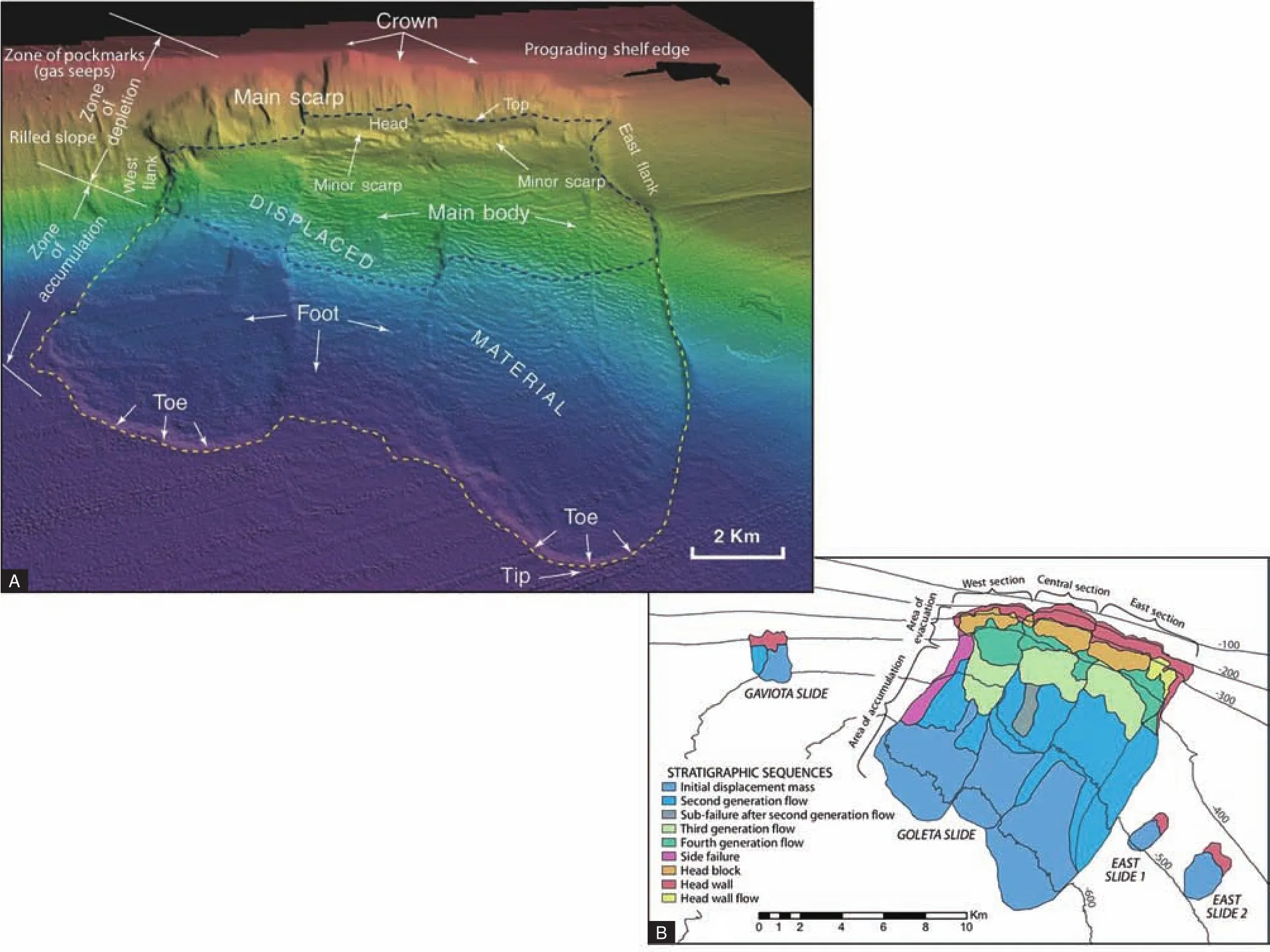

Figure 3 Seismic profile showing transparent (homogeneous) to chaotic internal reflections of slide deposits (SD). Note continuous and parallel internal reflections of contourite deposits (CD). The Storegga Slide on the mid-Norwegian continental margin. TNU=Local slip plane. Profile courtesy of A. Solheim. Modified after Solheim et al. (2005b). With permission from Elsevier Copyright Clearance Center’s RightsLink: Licensee: G. Shanmugam. License Number: 3570801423159. License Date: February 16, 2015.
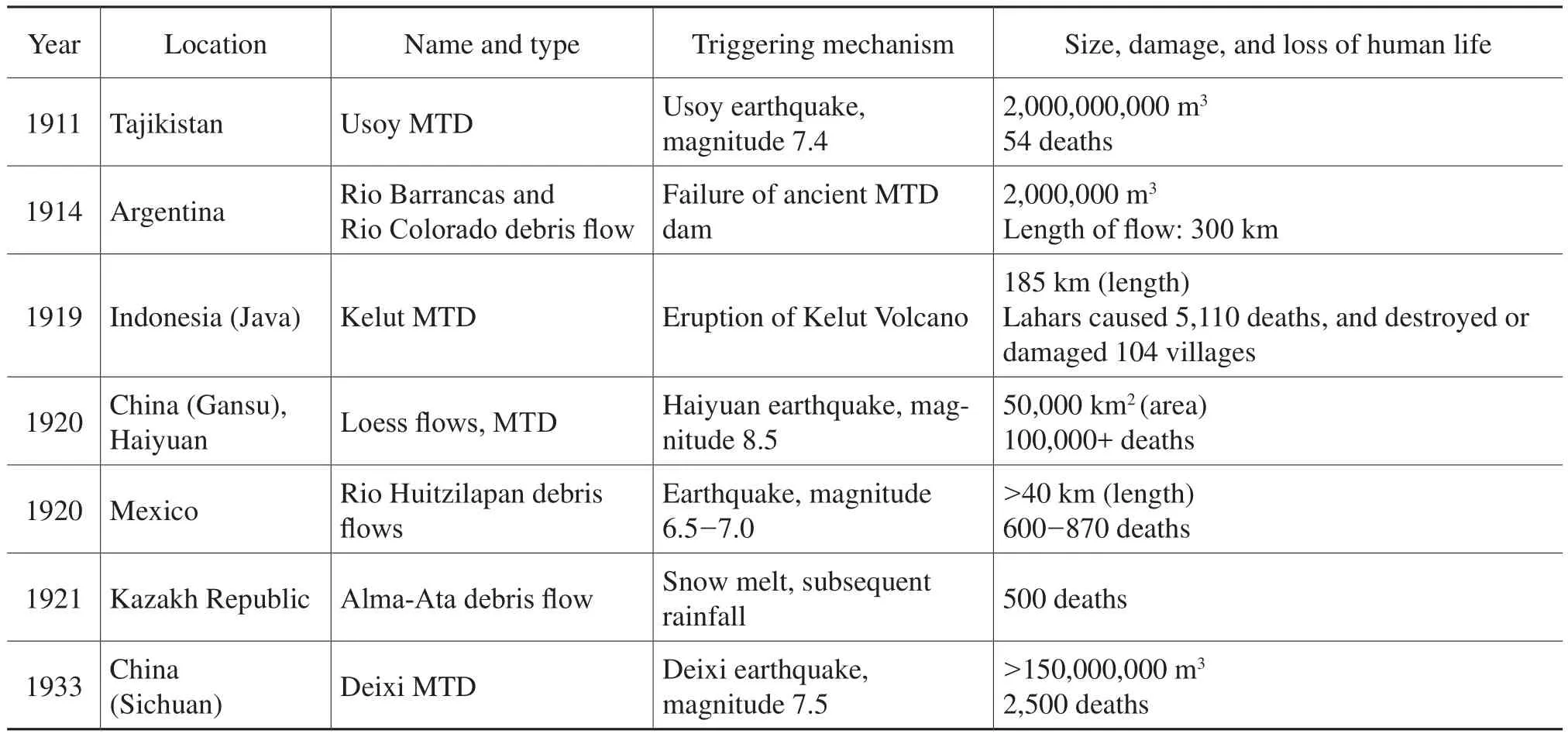
Table 1 Worldwide large subaerial and submarine mass?transport deposits (MTD), their sizes (volume), triggering mechanisms, and damages in the 20th and 21st Centuries. The term “l(fā)andslide” was originally used to describe these examples. Modified after USGS(2010).

Table 1, continued
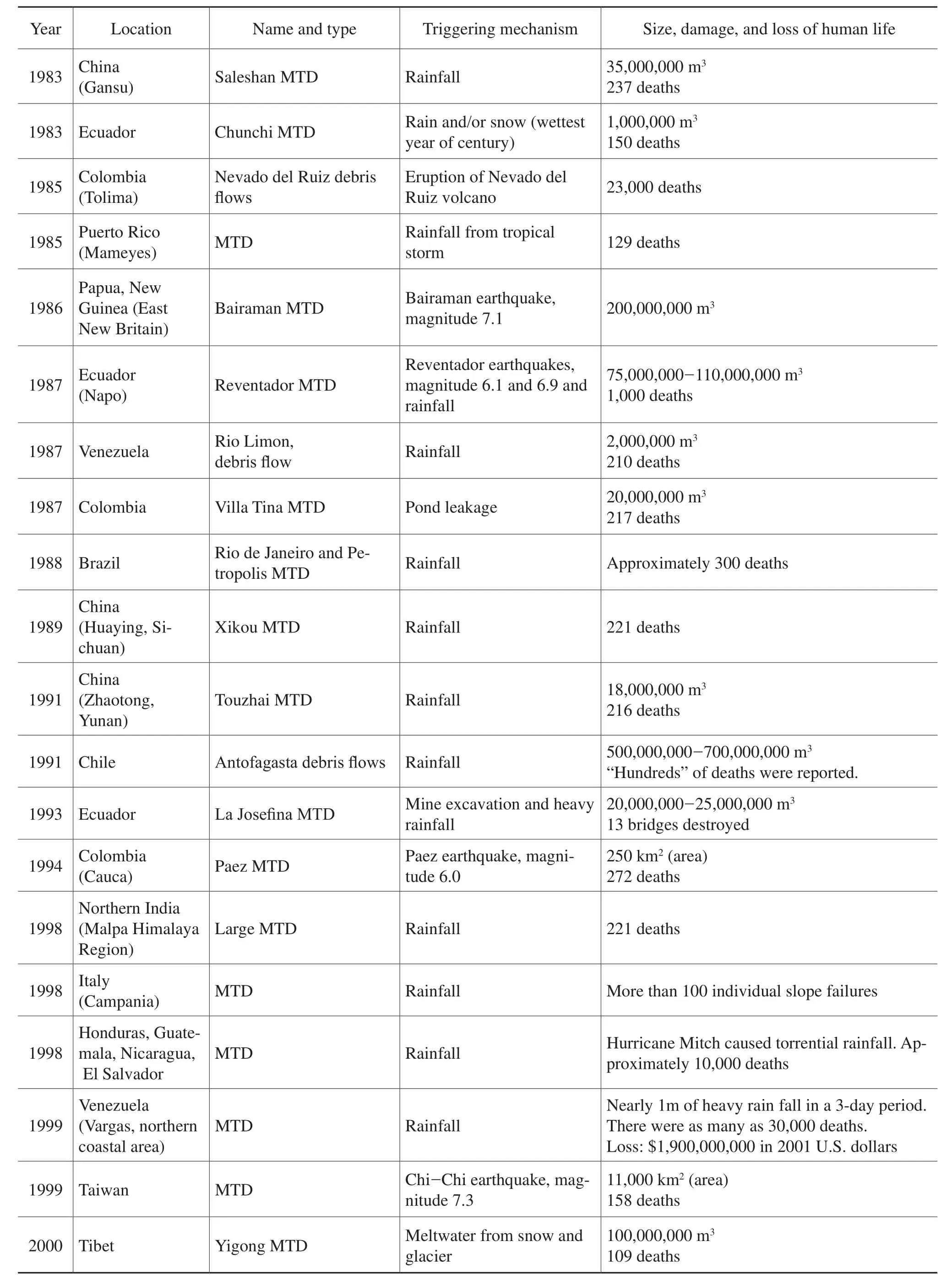
Table 1, continued
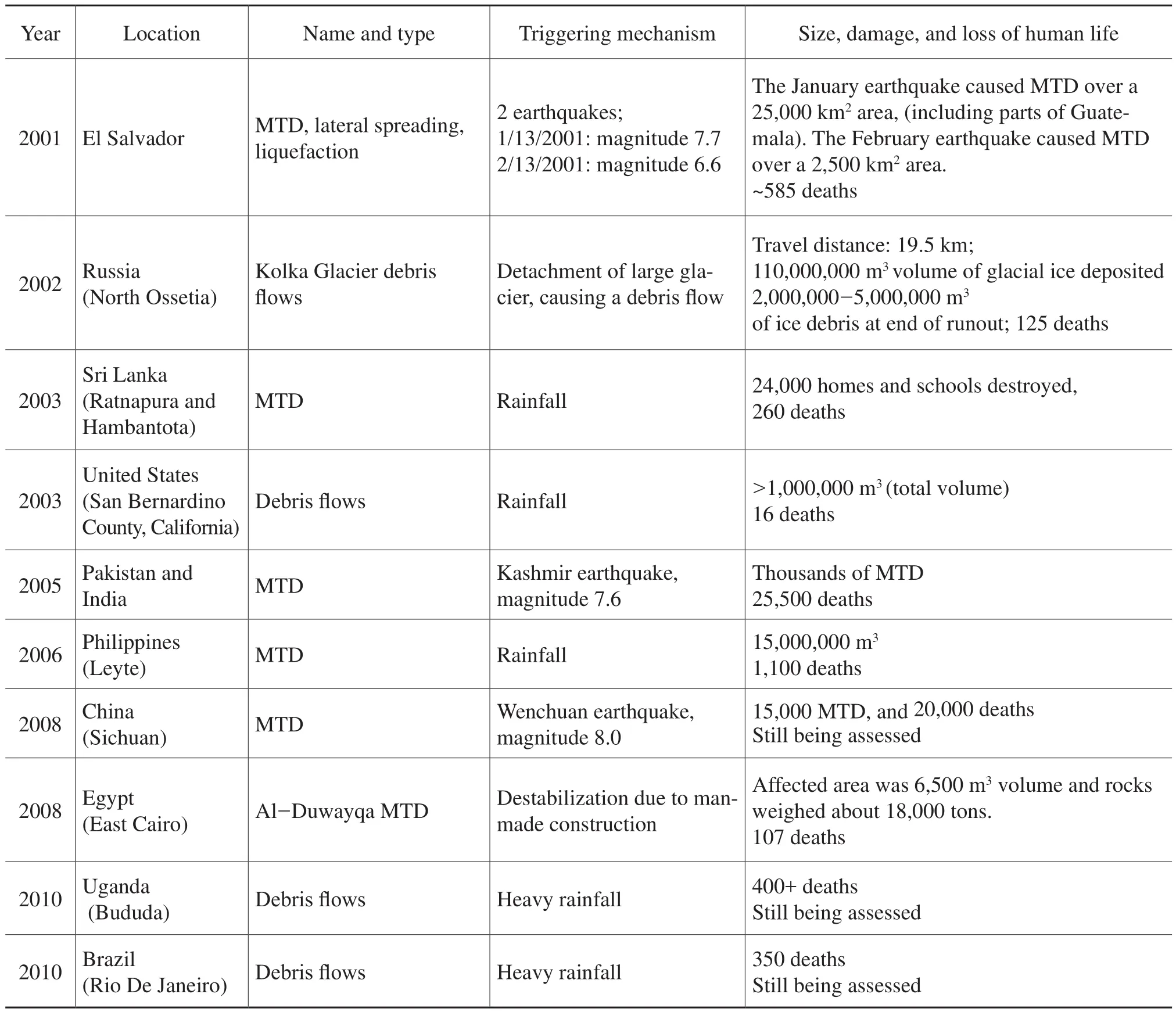
Table 1, continued
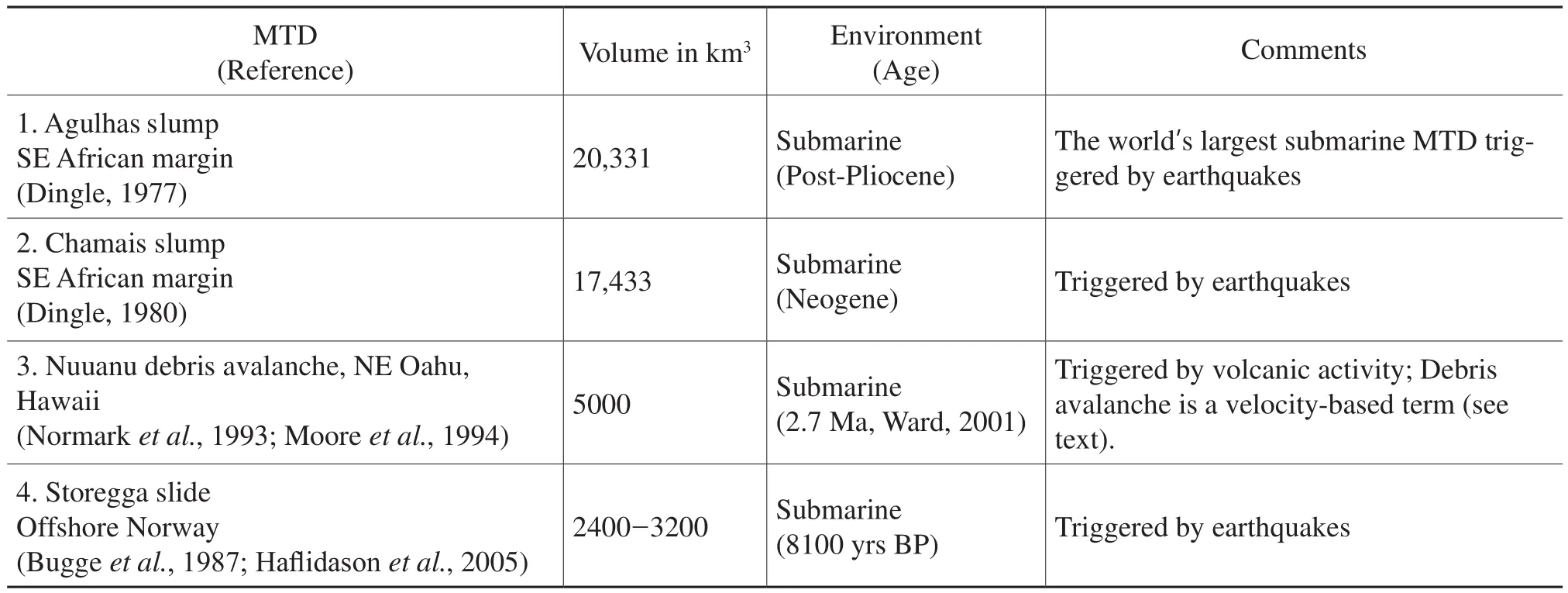
Table 2 Comparison of large?volume (> 100 km3) mass?transport deposits (MTD) in submarine environments with four of the largest MTD in subaerial environments. Note that the world’s largest submarine MTD (20,331 km3) is 10 times volumetrically larger than the world’s largest subaerial MTD (2000 km3). The term “l(fā)andslide” was used to describe many of these examples by the original authors.Locations of selected examples are shown in Figure 1. Compiled from several sources.

Table 2, continued
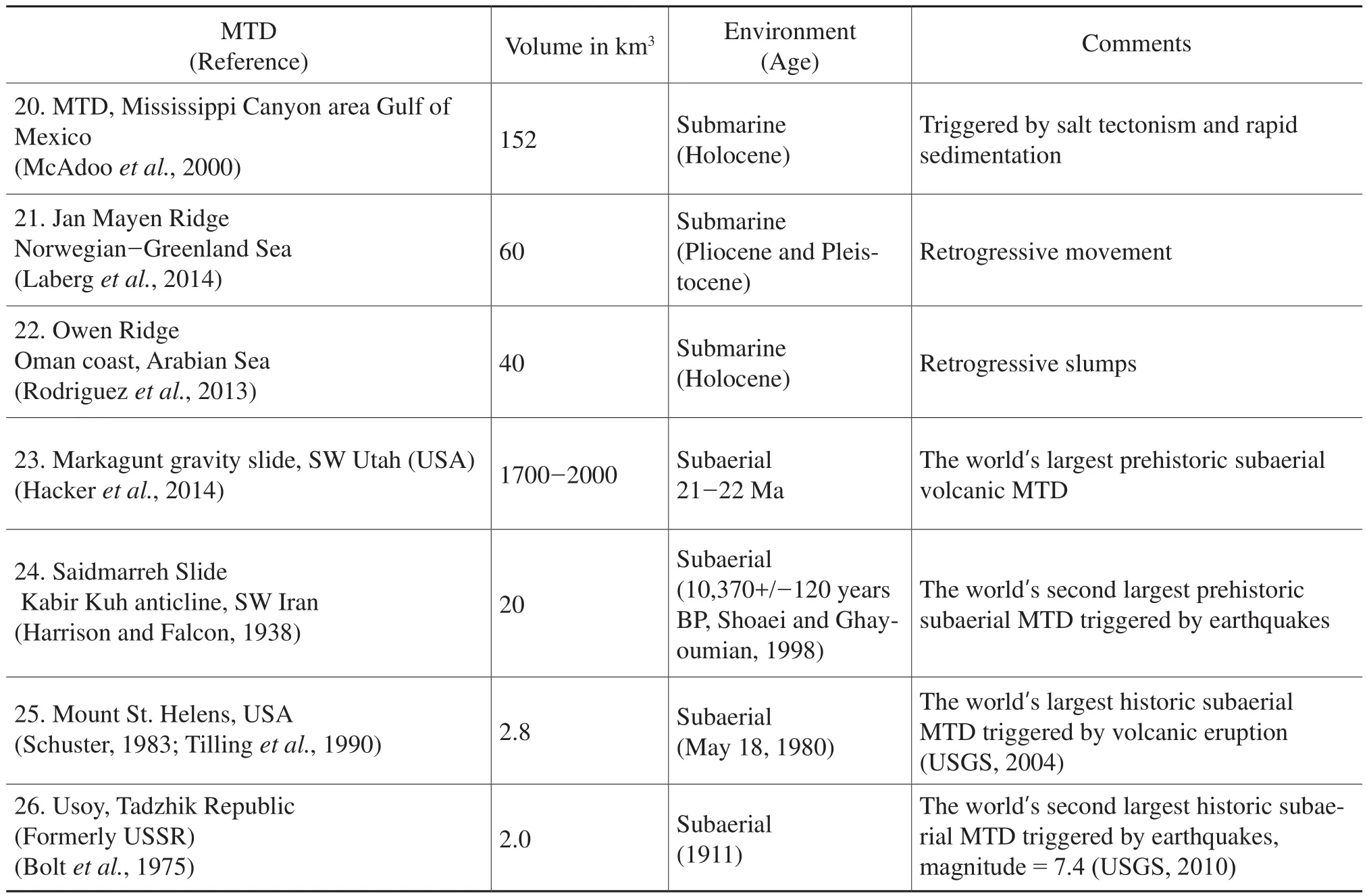
Table 2, continued
1.2 Description of the problem
The basic problem stems from our failure to follow a sound and commonly applied concept for classifying MTD. In acknowledging this chronic problem, Camer?lenghiet al.(2010, p. 506) state, “For typology,we selected the following terms according to the terminology in the original manuscripts:Debris Avalanche;debris flow;deep-seated failure(when recognized mainly in deep penetration seismic profiles rather than bathymetric maps);glide;gravitational collapse;mass failure;mass transport;mass wasting;megaturbidite;slide;slump.Such terms often describe similar deposits.For the time being we have not modified the terminology.It is obvious that a unified terminology is needed for correct understanding and comparison of sedimentary deposits originated from sub-marine sediment mass transport.” There is absolutely no sedimentological basis for equating large turbidites (i.e.,megaturbidites) with slumps, slides, or debris avalanches.The current complacent usage of superfluous nomencla?ture is not only confusing but unnecessary. Clearly, there is a need for conceptual clarity, which is one of the objectives of this article.
The conceptual and nomenclatural problems are not unique to MTD. Similar problems are associated with tur?bidites (Sanders, 1965; Shanmugam, 1996) and tsunamites(Shanmugam, 2006b). What is troubling is that the prob?lems of MTD are tightly intertwined with those of turbid?ites and tsunamites. This conceptual interconnection has led to a long lexicon of 79 types of MTD, which include normal turbidites, high?density turbidites, seismoturbid?ites, megaturbidites, fluxoturbidites, atypical turbidites,and tsuamites (Table 4).
Since the first use of the term “l(fā)andslide” by James Dwight Dana in 1838 (Cruden, 2003), it has been adopted for a number of different downslope mass?transport pro?cesses that operate not only in subaerial (Shreve, 1968;Coates, 1977; Cruden, 1991; Highland and Bobrowsky,2008), sublacustrine (Moernaut and De Batist, 2011), and submarine (Prior and Coleman, 1979; Schwabet al., 1993;Hamptonet al., 1996; Locat and Lee, 2000, 2002; Massonet al., 2006; Feeley, 2007; Twichellet al., 2009) environ?ments on Earth, but also in extraterrestrial environments on Venus (Malin, 1992), Mars (Lucchitta, 1979; McEwen,1989; Montgomeryet al., 2009), and Saturn’s satellite Iapetus (Singeret al., 2012), among others. At present,the literal meaning of the word landslide is totally lost in the geologic and engineering literature. For example, (1)Hungr (1995, p. 610) states, “…rapid landslides such as debris flows,debris avalanches,rock slide avalanches,large scale liquefaction failures,and slides…” in de?scribing subaerial mass?transport processes. (2) Twichellet al.(2009, their Figure 2d) labeled the toe of the “Cur?rituck landslide” as “Debris flow deposit” on a 3.5 kHz seismic profile from the U.S. Atlantic margin. (3) Singeret al.(2012, p. 574) state that “Here we analyse images from the Cassini mission and report numerous long?runout landslides on Iapetus, an icy satellite of exceptional topographic relief…We use the ratio of drop height to runout length as an approximation for the friction coefficient of landslide material.” The above three examples, selected among many other similar ones, reveal the following fun?damental problems:
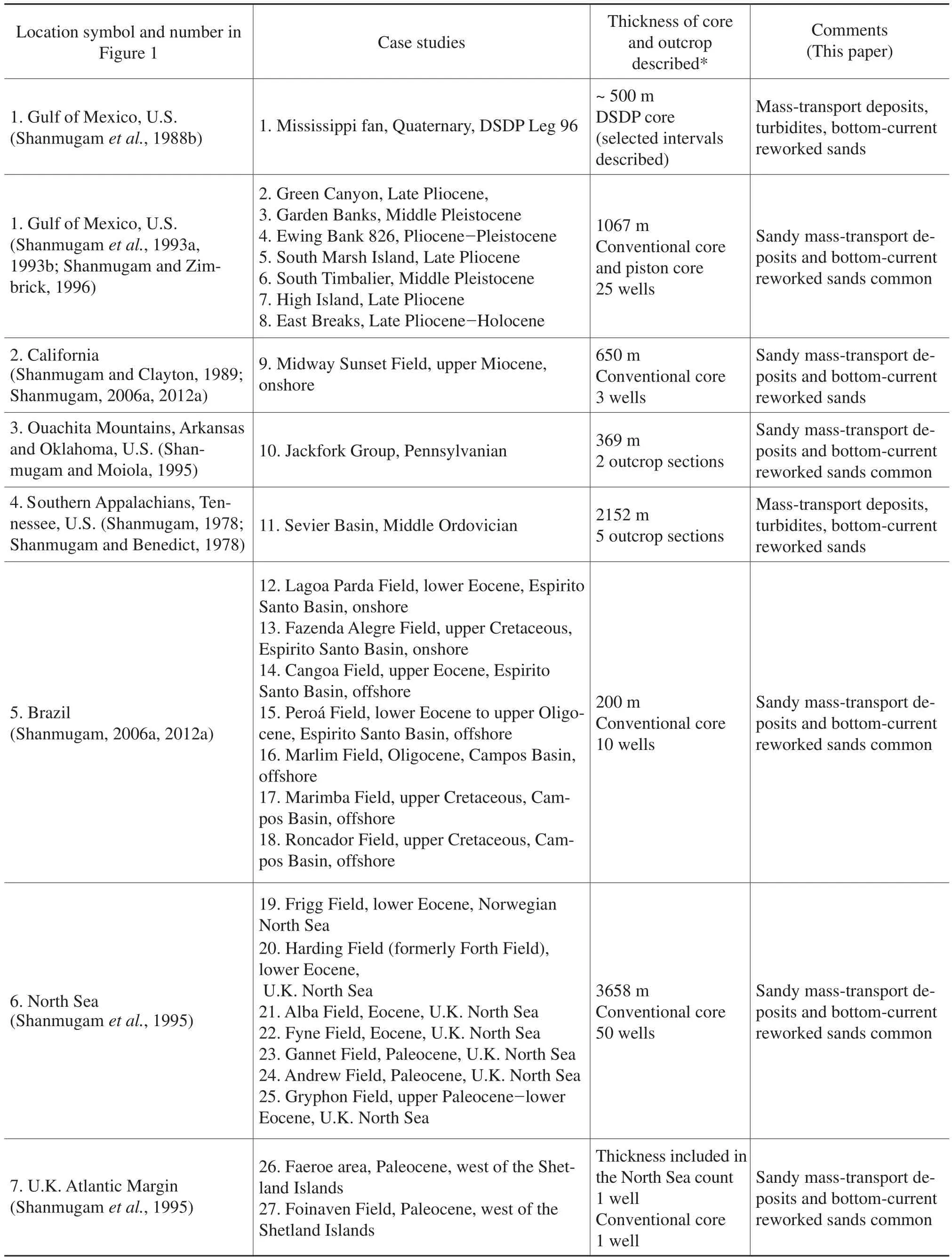
Table 3 Summary of deep?water case studies, based on description of core and outcrop, carried out by the present author on MTD and SMTD (1974-2011). Note that most SMTD examples are petroleum?bearing deep?water reservoirs. Modified after Shanmugam(2014b).
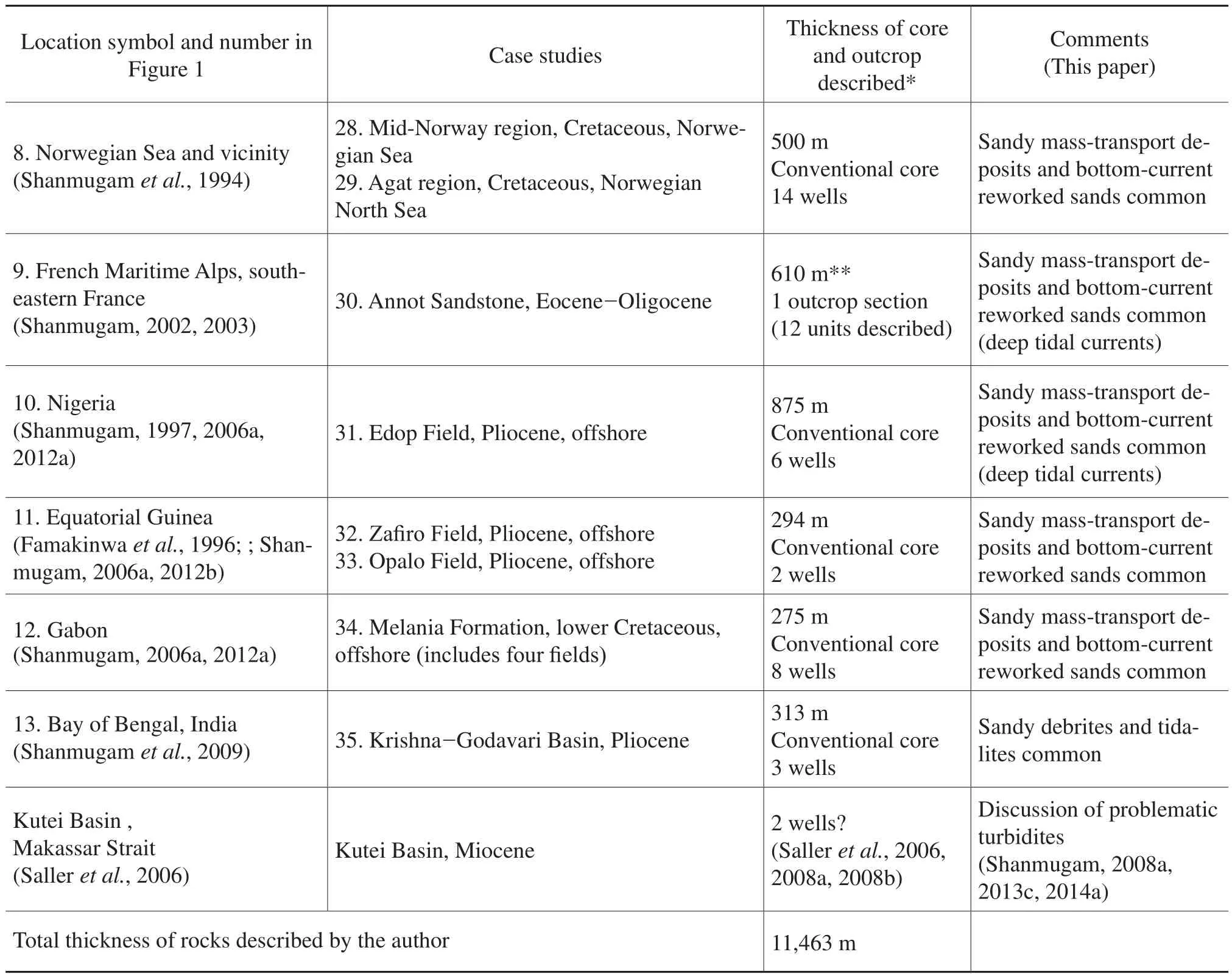
Table 3, continued

Table 4 Nomenclature of 79 different types of mass?transport processes and their deposits with overlapping and confusing meanings.Compiled from several sources. Updated after Shanmugam (2012a).
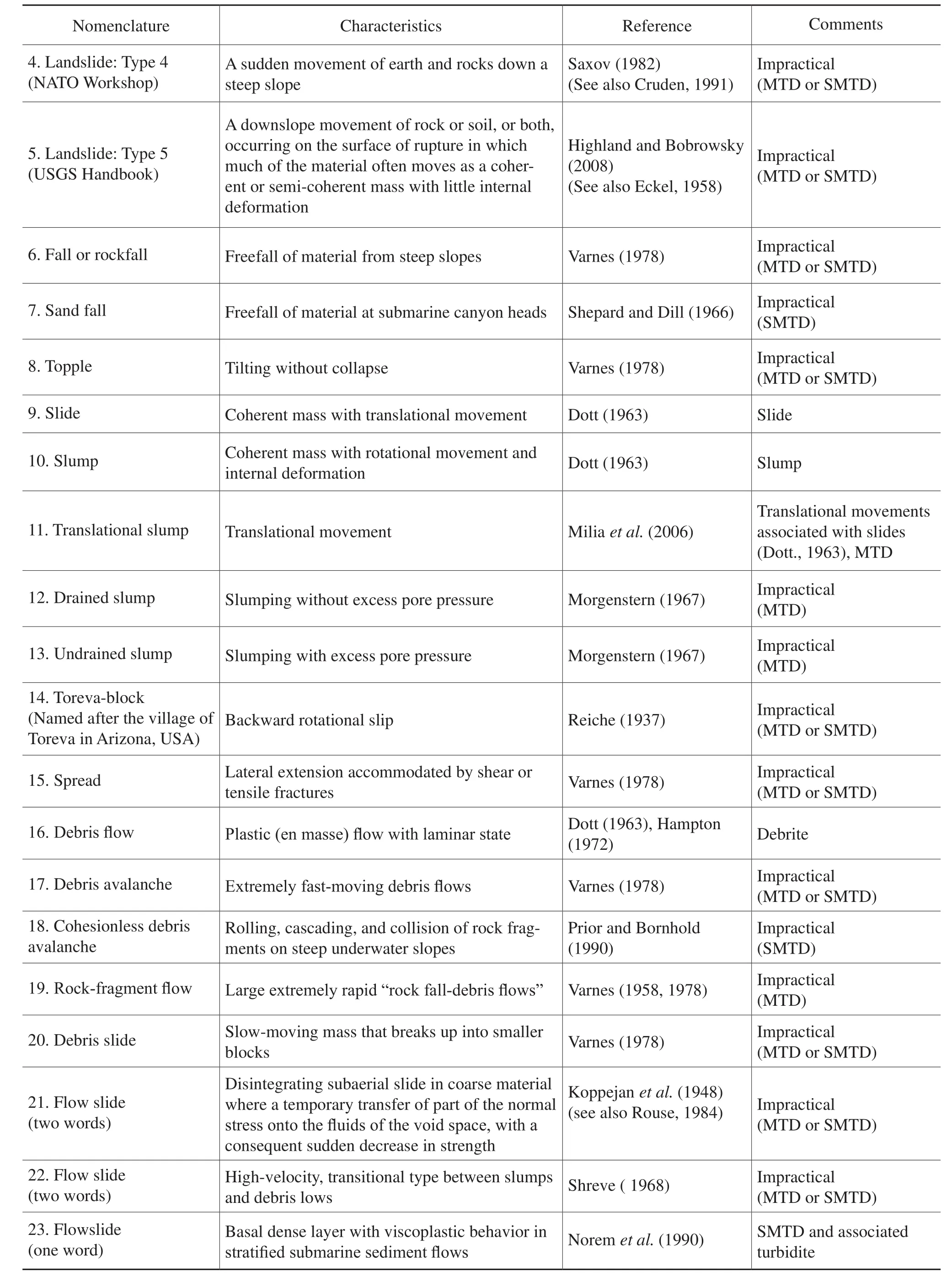
Table 4, continued

Table 4, continued

Table 4, continued

Table 4, continued
· The use of the term landslide, with a built?in refer?ence to a sliding motion, to represent topples without a sliding motion or debris flows with a flowing motion is er?roneous (Varnes, 1978). In acknowledging this basic prob?lem, Brabb (1991, p. 52) state “Note that Varnes prefers the term‘slope movements’.I will use the more familiar‘landslides’in this paper,even though many processes are loosely termed‘landslides’involve little or no true sliding.” This practice of postponing conceptual problems is chronic in this domain. For example, Hansen (1984, p. 1)states that “Demands for standardized terminology are common,and certainly moves have been made to improve definition(Varnes, 1978).As yet the move towards what might be called an impossible ideal is slow,but it still remains a worthy aim.” Disappointingly, Varnes (1984) him?self abandoned his own valuable aim and reverted back to the popular and confusing usage of the term “l(fā)andslide”for a variety of mass?transport processes that involve little or no sliding motion.
· Aspects of sediment failure and related sliding can be measured in modern subaerial environments by installing piezometers and inclinometers (Duncan and Wright, 2005, their Figure 2.7), but such measurements are impractical in modern deep?marine and extraterres?trial environments.
· Motion types can be determined by direct examina?tion of ancient strata in core or outcrop, but the distinction between sliding and flowing motions cannot be ascertained from seismic or radar images.
· The synonymous use of the term landslide for high?velocity debris avalanches is indefensible. This is because there are no objective criteria to distinguish low?velocity flows from high-velocity flows in the depositional record on Earth (Shanmugam, 2006a, 2012a). Nor is there any technique to measure velocity of mass movements on oth?er planets.
· The measure ofH/L(fall height/runout length) ratios of MTD on other planets using radar images and compari?son of such data withH/Lratios of MTD on Earth derived from outcrop or seismic data is incompatible.
· Although MTD on the U.S. Atlantic margin have been described as submarine landslides by Twichellet al.(2009), cores from some of these landslides are indeed composed of debrites (Embley, 1980).
The current landslide problem, somewhat analogous to the turbidite problem (Van der Lingen, 1969) and the tsunamite problem (Shanmugam, 2006b; Luczyński,2012) encountered earlier, requires a rigorous scrutiny of fundamental issues. Therefore, the primary objective here is to bring clarity to the classification of subaerial and submarine downslope processes by combining sound principles of fluid mechanics, soil mechanics, labora?tory experiments, study of modern deep?marine systems,and detailed examination of core and outcrop worldwide(Figure 1, Table 3). Specific objectives are: (1) to review the first principles of soil strength and slope stability; (2)to critically evaluate existing nomenclature and classifi?cation of downslope processes and select a meaningful scheme; (3) to establish criteria for recognizing process?specific depositional facies in the stratigraphic record us?ing core and outcrop; (4) to classify types of triggering mechanisms of sediment failures and to demonstrate their relevance in discarding popular sea?level models; (5) to discuss problems associated with long?runout mass move?ments; and finally (6) to emphasize the importance of rec?ognizing process-specific depositional facies in character?izing deep?water petroleum reservoir sands. This review with 403 references is intended for a broad international readership that includes students (both undergraduate and graduate), academic scholars, petroleum geoscientists,engineers, and managers.
1.3 Limitations and organization
There are limitations in organizing this paper in a con?ventional format with a coherent theme. First, this review is a blend of nomenclatural, conceptual, theoretical, ex?perimental, observational, and interpretational issues. As such, it is difficult to devote the same rigorous attention to details on each issue. For example, unlike sedimentologi?cal studies of landslides on Earth, rock?based sedimento?logical data of landslides on Mars and Venus are totally lacking. Second, the emphasis of submarine MTD in this article is intentional because of their global economic im?portance in petroleum exploration and production. Third,contrary to the popular usage of the term “l(fā)andslide” for all types of MTD by other researchers, this paper advocates the strict application of the term solely to a single MTD type. Fourth, in minimizing a tedious text, portions of the paper are organized using numbered or bulleted pithy statements. Fifth, in maintaining some continuity and clar?ity, selected text and figures are reused from the author’s previous publications.
By necessity, this iconoclastic review is organized,rather unorthodoxly and disjointedly, under the following main headings:
· Mechanics of sediment failure and sliding
· Nomenclature and classification
· Recognition of the three basic types of MTD
· Triggering mechanisms
· Long?runout mechanisms
· Reservoir characterization
2 Mechanics of sediment failure and sliding
Sediment failures on continental margins are controlled by the pull of gravity, the source of the material (bedrock vs. regolith), the strength of the soil (grain size, miner?alogy, compaction, cementation,etc.), the weight of the material, the slope angle, the pore?water pressure, and the planes of weaknesses. In order to evaluate sediment failures in general, one needs to conduct a slope stability analysis for describing the sediment behavior and sedi?ment strength during loading or deformation.
2.1 Soil strength and slope stability
The most fundamental requirement of slope stability is that the shear strength of the soil must be greater than the shear stress required for equilibrium (Duncan and Wright,2005; Shanmugam, 2014a). The two conditions that result in slope instability are (1) a decrease in the shear strength of the soil and (2) an increase in the shear stress required for equilibrium. The decrease in the shear strength of the soil is caused by variousin situprocesses, such as an in?crease in pore?water pressure, cracking of the soil, swell?ing of clays, leaching of salt,etc.The increase in shear stress is induced by loads at the top of the slope, an in?crease in soil weight due to increased water content, seis?mic shaking,etc.
A common method for calculating the slope stability is the ‘Limit equilibrium analyses’ in soil mechanics. A sta?ble slope can be maintained only when the factor of safety for slope stability (F) is larger than or equal to 1 (Duncan and Wright, 2005, their equations 6.1 and 13.2):

where
S=Available shear strength, which depends on the soil weight, cohesion, friction angle, and pore?water pressure.
τ=Equilibrium shear stress, which is the shear stress required to maintain a just?stable slope. It depends on the soil weight, pore?water pressure, and slope angle.
The shear strength is equal to the maximum shear stress which can be absorbed by the slope without failure and can be defined by the Mohr-Coulomb failure criterion:

where
S=Available shear strength (Figure 4A)
c=Cohesion (nonfrictional) component of the soil strength
σ=Total normal stress acting on the failure surface
φ=Angle of internal friction of the soil
By combining the equations of shear strength and Mohr?Coulomb failure criterion, the factor of safety (F)can be expressed as:

A sediment failure is initiated when the factor of safety for slope stability (F) is less than 1 (Figure 4B). In other words, the sliding motion along the shear surface com?mences only when the driving gravitational force exceeds the sum of resisting frictional and cohesive forces. Initial porosity of the sediment plays a critical factor in con?trolling the behavior of the shear surface (Anderson and Riemer, 1995). Based on an experimental study on land?slides initiated by rising pore?water pressures, Iversonet al.(2000) reported that even small differences in initial porosity had caused major differences in mobility. For ex?ample, wet sandy soil with 50% porosity contracted during slope failure, partially liquefied, and accelerated to a speed of over 1 m s-1, whereas the same soil with 40% porosity dilated during failure, slipped episodically, and traveled at a slow velocity of 0.2 cm s-1. Finally, soil strength differs between drained and undrained conditions (Terzaghiet al.,1996; USACE, 2003; Duncan and Wright, 2005).
Slides occur commonly on modern slopes of 1-4°(Boothet al., 1993) (Figure 5). Contrary to the popular belief, most submarine slides occur on gentle slopes of less than 4°, sometimes even at 0.25°. Submarine slides on slopes greater than 10° are rare (Figure 5).
2.2 The role of excess pore-water pressure
Terzaghi (1936) first recognized that pore-water pres?sure controls the frictional resistance of slopes, which has remained the most important concept in understanding landslide behaviour. A founding principle of slope stabil?ity is that a rise in pore?water pressure reduces the shear strength of the soil (Skempton, 1960). The shear strength of soil, in particular clays, is controlled by the frictional re?sistance and interlocking between particles (i.e., physical component), and interparticle forces (i.e., physicochemi?cal component) (Karcz and Shanmugam, 1974; Parchure,1980; Hayteret al., 2006). Furthermore, bed density and shear strength of soil increase with increasing consolida?tion (Hanzawa and Kishida, 1981; Dixit, 1982). A rise in pore?water pressure occurs when the saturated soil is stressed, and when the porosity cannot increase or the pore fluid cannot expand or escape through fractures. The ex?cess pore?water pressure has been considered a vital factor in explaining the origin of subaerial mass?transport pro?cesses (Johnson, 1984; Anderson and Sitar, 1995; Iverson,1997, 2000; Iversonet al., 1997; Jakob and Hungr, 2005).Iverson (1997), based on studies of coarse?grained subae?rial debris flows, has developed a model in which excess pore?water pressure causes liquefaction of the sediment and thereby strongly reduces internal friction and increas?es sediment mobility or runout distances.
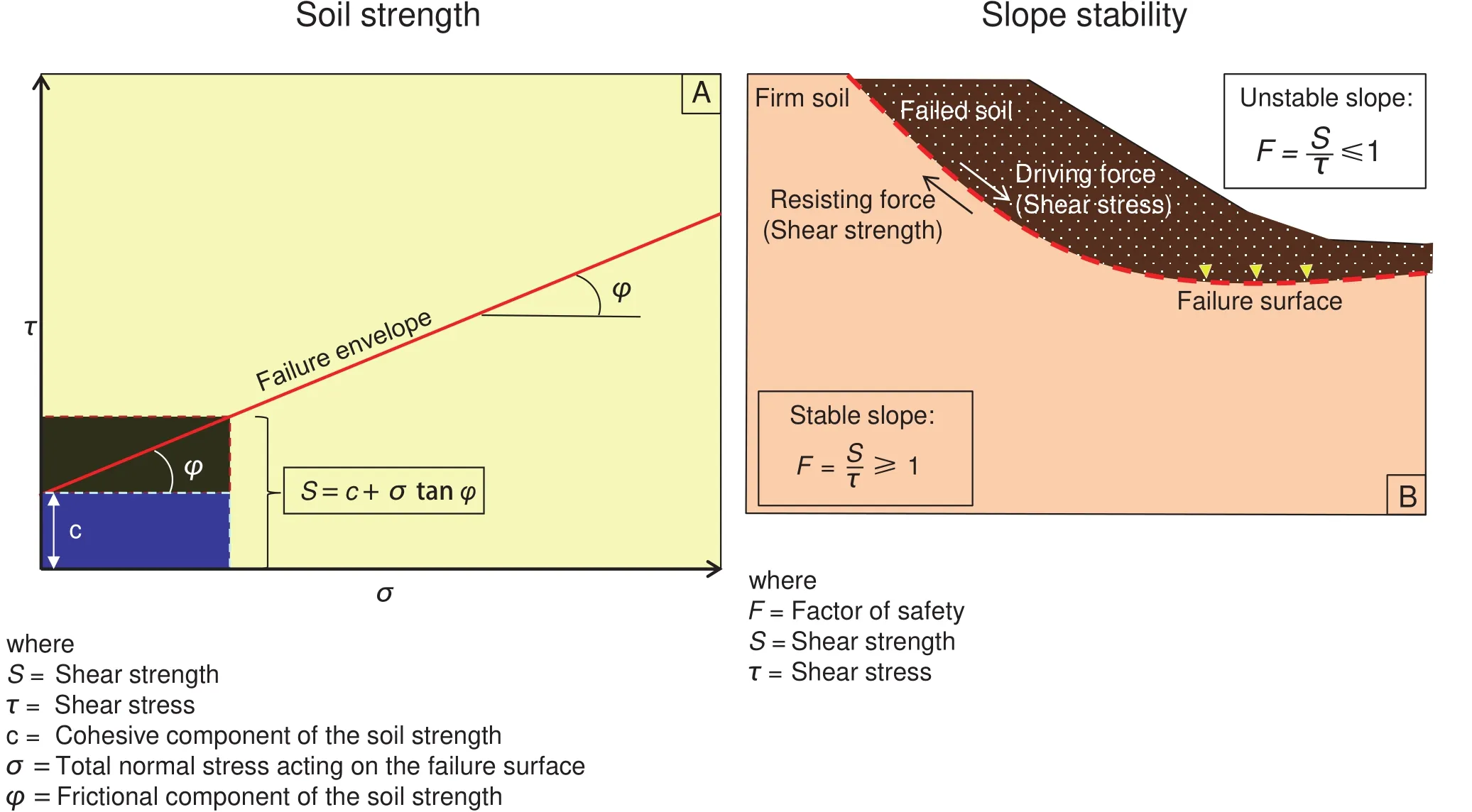
Figure 4 A-Plot showing that the shear strength of the soil (s) is composed of frictional (φ) and cohesive (c) components; BConceptual diagram showing that a stable slope can be maintained only when the factor of safety for slope stability (F) is larger than or equal to 1 (Duncan and Wright, 2005). The sliding motion of failed soil mass commences along the shear surface when the factor of safety (F) is less than 1. Synonyms: Failure surface = slip surface = shear surface = primary glide plane. Compiled from several sources(e.g., USACE, 2003; Duncan and Wright, 2005). From Shanmugam (2014a).With permission from AAPG.
Excess pore?water pressures have also been consid?ered a characteristic property in explaining long?runout submarine MTD (Suhayda and Prior, 1978; Hamptonet al., 1996; Iversonet al., 1997; Geeet al.1999; Major and Iverson, 1999). Submarine debris flows have lower yield strengths than subaerial debris flows due to entrainment of sea water (Pickeringet al., 1989) and elevated pore?water pressure (Pierson, 1981).
Laboratory measurements of pore?water pressure have shown that the front of the subaqueous clayey debris flow exhibits hydroplaning (Mohriget al., 1998) on a thin layer of water, which causes low bed friction. Fronts of sandy debris flows show a fluidized head where bed friction is minimal (Ilstadet al., 2004). A 5?m thick submarine sandy
debris flow, with a long-runout distance of over 400 km downslope of the Canary Islands, has been attributed to the development of excess pore?water pressure due to loading induced by a pelagic debrite package (Geeet al., 1999,their Figure 12). Problems associated with long?runout MTDs are discussed below (Section 6).
3 Nomenclature and classification
3.1 Landslide versus mass transport
Although the term landslide is deeply entrenched in the literature, there are inherent problems associated with the usage.
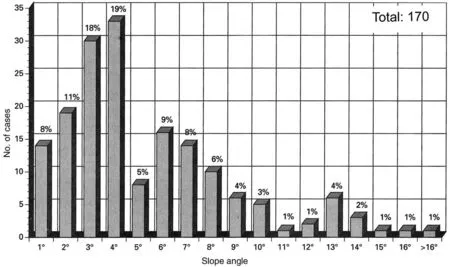
Figure 5 Histogram showing frequency distribution of submarine slides with increasing slope angle, U.S. Atlantic Continental Slope.Note most slides occur on gentle slopes of less than 4°. This compilation of empirical data from modern examples is helpful to the petroleum industry for understanding ancient slides and palaeogeography. From Booth et al. (1993). With permission from USGS.
1) For his first paper, Varnes (1958) used the title“Landslide types and processes” that included fall, topple,spread, translational slide, rotational slide, and flow. But for his second paper, Varnes (1978) changed the paper title to “Slope movement types and processes” to represent the same six processes, namely (a) fall, (b) topple, (c) spread,(d) translational slide, (e) rotational slide, and (f) flow (Fig?ure 6). In abandoning the term landslide, Varnes (1978, p.11) eloquently explained that “One obvious change is theterm slope movements,rather than landslides,in the title of this paper and in the classification chart.The term landslide is widely used,and no doubt,will continue to be used as an all inclusive term for almost all varieties of slope movements,including some that involve little or no true sliding.Nevertheless,improvements in technical communication require a deliberate and sustained effort to increase the precision associated with the meaning of words,and therefore the term slide will not be used to refer to movements that do not include sliding.” This cautionary note, which has been obviously ignored by other research?ers, is the underpinning principle of this paper.
2) The term landslide literally implies sliding motion of a rigid body of earth or land along a shear surface. But debris flows, considered to be a part of the landslide family in some classifications (Cruden, 1991), are characterized by intergranular movements, not shear?surface movements(Shanmugamet al., 1994; Iversonet al., 1997).
3) The AGI Glossary of Geology (Bates and Jackson,1980, p. 349) defined a landslide as “A general term covering a wide variety of mass movement landforms and processes involving the downslope transport, under gravitational influence, of soil and rock material en masse. Usually the displaced material moves over a relatively con-fined zone or surface of shear.” This definition, although implies that the shear?surface movement is a critical factor(see Figure 4B), includes a variety of mass movements.
4) According to Cruden (1991), “A landslide is the movement of a mass of rock,earth or debris down a slope”.This broad definition includes not only slides, but also de?bris flows. There are at least five different definitions of the term landslide with conflicting meanings (Table 4).
5) Geertsemaet al.(2009, p. 59) state that “Landslides include debris flows and slides,earth flows and flowslides,rock falls,slides,and avalanches,and complex landslides involving both rock and soil.” On the one extreme, the term landslide has been applied without any implication for a specific process (Geeet al., 2007; Camerlenghiet al.,2010), but on the other extreme, the term landslide repre?sents only one category within a larger phenomenon called mass movements (Coates, 1977).
6) The U.S. Geological Survey uses the term landslide to include debris avalanche and creep with velocity con?notations (Highland and Bobrowsky, 2008). However, ve?locities of transport processes cannot be interpreted from bathymetric images of modern seafloor or by examining the ancient rock record in core and outcrop (see Section 3.4 on ‘Classification based on transport velocity’ below).
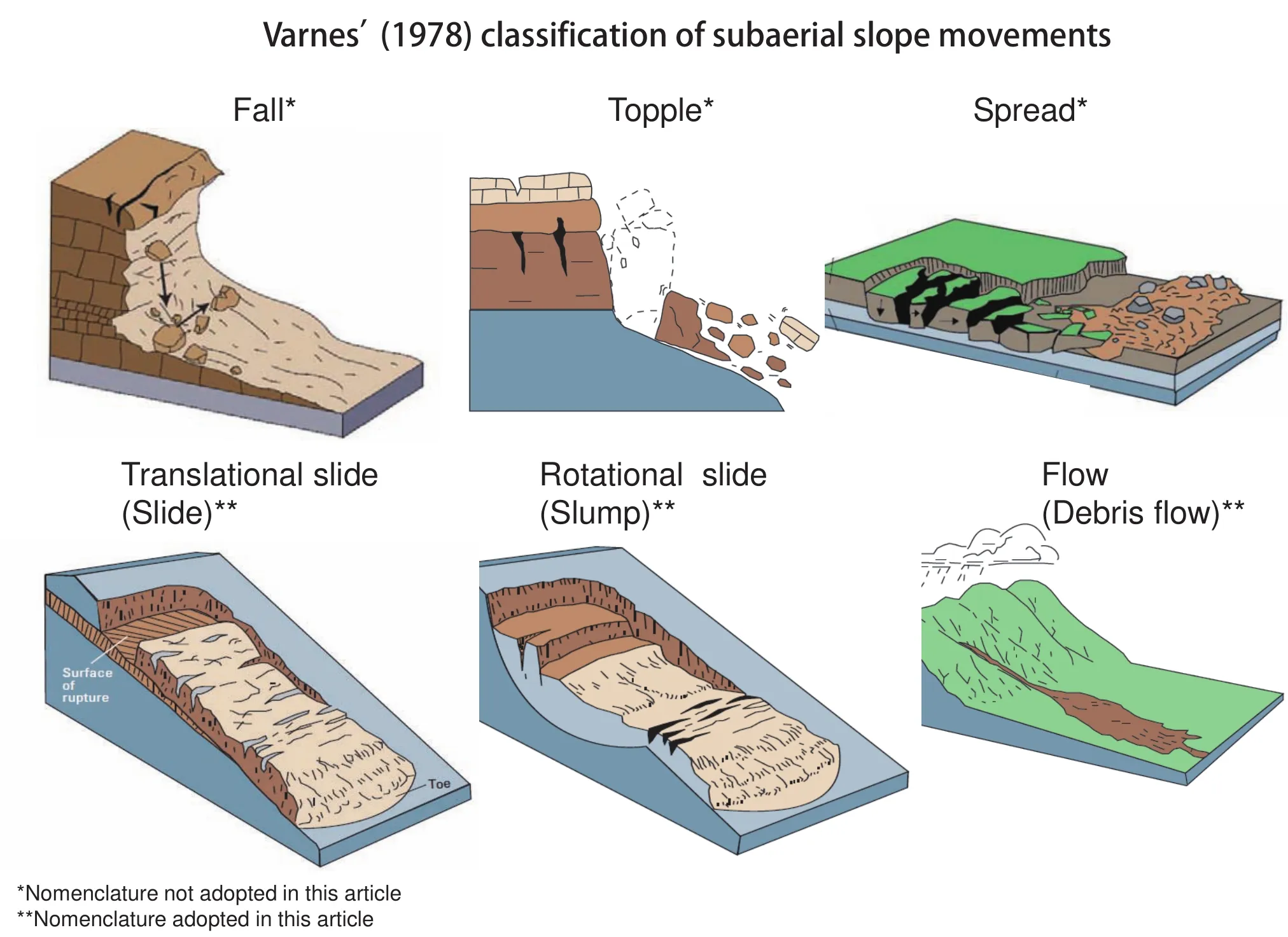
Figure 6 Classification of subaerial slope movements into six types by Varnes (1978). Note that the term “l(fā)andslide” was not used in his 1978 classification, but was used by Varnes (1958) in his previous classification. Also note that the processes fall, topple, and spread are not adopted in this article because deposits of these processes are difficult to distinguish from deposits of debris flows (i.e.,debrites). See Cruden and Varnes (1996) and Wieczorek and Snyder (2009) for an expanded classification of Varnes (1978) with four additional types: (1) debris avalanche, (2) earthflow, (3) creep, and (4) lateral spread. See text for a critique of these additional terms.Diagram modified after Highland and Bobrowsky (2008). With permission from USGS.
7) Even the International Geoscience Programme(IGCP-585), now called E?MARSHAL (Earth’s conti?nental margins: assessing the geohazard from submarine landslides) uses the word landslide for all submarine mass movements (E?MARSHAL, 2013).
8) Similarly, the Springer journal “Landslides” (Editor?in-Chief: Kyoji Sassa) defines that “Landslides are gravitational mass movements of rock,debris or earth”, without a distinction between landslides and mass movement. Credit:http://www.springer.com/earth+sciences+and+geography/natural+hazards/journal/10346 (accessed December 27,2014).
The use of the term landslide is inappropriate as a gen?eral term to represent both the shear?surface ‘sliding’ mo?tion of a rigid body and the intergranular ‘flowing’ motion of a plastic mass (Shanmugamet al., 1994). A more ap?propriate general term is “mass transport” or “mass move?ment”, which represents the failure, dislodgement, and downslope movement of either sediment or glacier under the influence of gravity. The advantage of the general term“mass transport” is that there is no built?in reference to a sliding motion. Nor is there any reference to sediment or glacier.
3.2 Classification based on types of movement and material
Varnes (1978, his Figure 2.1) classified subaerial masstransport processes into six movement?based types: (1)falls (2) topples, (3) translational slides, (4) rotational kinds, (5) spreads, and (6) flows (Figure 6). Further, Var?nes (1978) added the prefix “rock” to the process names and established the material?based types: (1) rock fall (2)rock topple, (3) rock slide, (4) rock slump, (5) rock spread,and (6) rock flow or deep creep. Although the spreads,topples, and falls could be observed in modern subaerial environments, the deposits of these three processes in the ancient rock record would not have any distinguishing attributes. This is because deposits of spreads, topples,and falls would resemble debrites (i.e., deposits of debris flows). Therefore, these three types are not adopted in the present article (Figure 6).
3.3 Classification based on mechanical behavior
Dott (1963, his Figure 7) proposed the most meaningful and practical classification of subaqueous mass-transport processes. It is somewhat analogous to the most widely accepted classification of subaerial mass-transport pro?cesses by Varnes (1958). In this scheme, subaqueous pro?cesses are broadly classified into (1) elastic, (2) elastic and plastic, (3) plastic, and (4) viscous fluid types based on mechanical behavior (Figure 7). The elastic behavior rep?resents rockfall; the elastic and plastic behavior comprises slide and slump; the plastic behavior represents debris flow, and the viscous fluid represents Newtonian turbidity current. The importance of Dott’s (1963) classification is that mass?transport processes do not include turbidity cur?rents (Figure 7C). In this classification, a rockfall refers to sudden falling of rock fragments on steep slopes, such as submarine canyonheads. Because recognition of rockfall in the ancient record is impractical, it is not considered here as a separate type. In short, mass?transport processes are composed of three basic types: (1) slide, (2) slump, and(3) debris flow (Figure 7). I have adopted Dott’s (1963)classification in this review because theoretical analysis(Shanmugam, 1996), experimental observations (Shan?mugam, 2000; Marret al., 2001), and empirical data (Ta?ble 3) overwhelmingly show that turbidity currents are not mass?transport processes.
The underpinning principle of Dott’s (1963) classifica?tion is the separation of solid from fluid mode of transport based on sediment concentration. In the solid (elastic and plastic) mode of transport, high sediment concentration is the norm (25%-100% by volume, Figure 7B). Mass?transport mechanisms are characterized by solid blocks or aggregate of particles (mass). In contrast, individual particles are held in suspension by fluid turbulence in tur?bidity currents (Dott, 1963; Sanders, 1965). Turbidity cur?rents are characterized by low sediment concentration of 1%-23% by volume (Figure 7B). In other words, turbidity currents are innately low in flow density. A simple anal?ogy to high?volume sediment transport by mass?transport processes is the human transport by a double?decker bus with a capacity to carry 73 passengers at a time (Figure 8A). In contrast, low?volume sediment transport by tur?bidity currents is analogous to human transport by a mi?crocar with a capacity to carry only two passengers at a time (Figure 8B). Clearly, mass transport is a much more efficient mechanism for moving sediment downslope than a turbidity current. Mass transport can operate in both subaerial and subaqueous environments, whereas turbid?ity currents can operate only in subaqueous environments.The advantage of this classification is that physical fea?tures preserved in a deposit directly represent the physics of sediment movement that existed at the final moments of deposition.
3.4 Classification based on transport velocity
The concept of velocity-based classification was first introduced by Sharpe (1938) and later adopted by Varnes(1958, 1978) for subaerial processes. There are at least 10 different factors that are commonly used in classifying landslides by various authors (Hansen, 1984, Table 1.1).These factors are: (1) climate, (2) material moved, (3) co?herence of material, (4) size of material, (5) geology, (6)type of movement, (7) speed of movement, (8) medium of movement: water/air/ice, (9) triggering mechanisms, and(10) morphological attributes. These 10 conflicting phi?losophies and related classifications have resulted in the current conceptual and nomenclatural crisis (Table 4). The velocity?based terms, such as avalanches, have also been adopted for downslope subaqueous processes when inter?preting seismic and bathymetric data (Wynnet al., 2000;Lewis and Collot, 2001; Massonet al., 2006). Examples of velocity?based terms are as follows:
1) The term flow slide has been used for high-velocity subaerial processes that could be considered a transition?al type between slumps and debris flows (Shreve, 1968;Rouse, 1984).
2) A slow?moving mass that breaks up into smaller blocks as it advances is called debris slide, whereas a fast?moving mass that breaks up into smaller blocks as it ad?vances is called debris avalanche (Varnes, 1978). The ve?locity of debris avalanches is 5 m·s-1(Cruden and Varnes,1996; see also Hungret al., 2001).
3) Catastrophic (fast-moving) debris flows are called sturzstrom (Hsü, 1975, 2004).
4) The term creep refers to a slow?moving mass move?ment (Bates and Jackson, 1980). There are nine kinds of creep depending on material and movement: (a) deep creep, (b) soil creep, (c) seasonal creep, (d) continuous creep, (e) progressive creep, (f) talus creep, (g) slump creep, (h) mass creep, and (i) rock?glacier creep (Shan?mugam, 2012a).

Figure 7 A-Schematic diagram showing four common types of gravity?driven downslope processes that transport sediment into deep?marine environments. A slide represents a coherent translational mass transport of a block or strata on a planar glide plane (shear surface) without internal deformation. A slide may be transformed into a slump, which represents a coherent rotational mass transport of a block or strata on a concave-up glide plane (shear surface) with internal deformation. Upon addition of fluid during downslope movement, slumped material may transform into a debris flow, which transports sediment as an incoherent mass in which intergranular movements predominate over shear-surface movements. A debris flow behaves as a plastic laminar flow with strength. As fluid con?tent increases in debris flow, the flow may evolve into Newtonian turbidity current. Not all turbidity currents, however, evolve from debris flows. Some turbidity currents may evolve directly from sediment failures. Turbidity currents can develop near the shelf edge,on the slope, or in distal basinal settings. From Shanmugam et al. (1994); B-Sediment concentration (% by volume) in gravity?driven processes. Slides and slumps are composed entirely of sediment (100% by volume). Debris flows show a range of sediment concentra?tion from 25% to 100% by volume. Note that turbidity currents are low in sediment concentration (1%-23% by volume); implying low-density flows. These concentration values are based on published data by various authors (see Shanmugam, 2000, his Figure 4 for details); C-Based on mechanical behavior of gravity?driven downslope processes, mass?transport processes include slide, slump, and debris flow, but not turbidity currents (Dott, 1963); D-The prefix “sandy” is used for mass-transport deposits that have grain (>0.06 mm: sand and gravel) concentration value equal to or above 20% by volume. The 20% value is adopted from the original field clas?sification of sedimentary rocks by Krynine (1948). See Shanmugam (1996) for discussion on high-density turbidity currents. Modified after Shanmugam et al. (1994). With permission from AAPG. Modified after Shanmugam (2012a). With permission from Elsevier Cop?yright Clearance Center’s RightsLink: Licensee: G. Shanmugam. License Number: 3567880649113. License Date: February 14, 2015.

Figure 8 Comparison of human transport on land with gravity?driven sediment transport under water in illustrating the importance of sediment concentration. A-Difference between a double?decker bus with a capacity to carry at least 73 passengers and a microcar with a capacity for only two passengers; B-Difference between mass?transport processes with high sediment concentration (25%-100%by volume) and turbidity currents with low sediment concentration (1%-23% by volume). Sediment mass transport = bus transport.Turbidity current transport = microcar transport. Both bus and mass transport are extremely efficient systems for high-volume transport(long arrow). SC = Sediment concentration. Reproduced from Shanmugam (2012a). With permission from Elsevier Copyright Clear?ance Center’s RightsLink: Licensee: G. Shanmugam. License Number: 3567880649113. License Date: February 14, 2015.
Although fast?moving and slow?moving mass?transport processes have been classified using absolute velocity val?ues (Cruden and Varnes, 1996; Hungret al., 2001), these velocity?based terms are not based on empirical data. For example, it is difficult to measure velocities of processes in modern deep?water environments because of common de?struction of velocity meters by catastrophic mass?transport events (Inmanet al., 1976; Shepard and Marshall, 1978).Cable breaks were used to estimate velocity of submarine mass?transport processes, triggered by the 1929 Grand Banks earthquake in offshore Newfoundland, Canada,which traveled at a speed of 67 km·h-1(Piperet al., 1988).But such velocity values are not based on direct measure?ments. Therefore, we do not know whether those cables were broken by slumps, debris flows, or turbidity currents.More importantly, there are no sedimentological criteria to determine the absolute velocities of sediment movement in the ancient rock record. This is because sedimentary features preserved in the deposits cannot and do not re?flect absolute transport velocities. The practice of deter?mining flow velocity from grain size using the Hjulstr?m Diagram, meant for fluvial processes (Sundborg, 1956), is inapplicable to MTD. This is because grain size is not pro?portional to flow velocity in mass-transport processes. In California, for example, it has been well documented that a slow?moving (at velocities of a few centimeter per day)debris flow with strength can detach a house from its foun?dation and transport it downslope. The other complication is that a debris flow can transform into turbidity current(Hampton, 1972), which is called surface transformation(Fisher, 1983). But there are no objective sedimentological criteria for interpreting flow transformation from the depo?sitional record. In other words, the velocity?based terms are impractical and therefore meaningless for interpreting the ancient geologic record.
3.5 Classifications with emphasis on turbidity currents
A plethora of classifications on deep-water processes and facies models, with a skewed emphasis on turbidity cur?rents, exists (Bouma, 1962; Mutti and Ricci Lucchi, 1972;Middleton and Hampton, 1973; Lowe, 1982; Stow, 1985;Pickeringet al., 1989; Mutti, 1992; Mulder, 2011; Tallinget al., 2012). Middleton and Hampton (1973) proposed a classification, based on sediment-support mechanisms, in which turbidity currents were considered as mass flows.Some authors (Nardinet al., 1979, their Table 3; Nemec,1990, his Figure 6; Martinsen, 1994, his Figure5.1; Mulder and Cochonat, 1996, their Figure11 and 13; Locat and Lee,2002, their Figure 2) have included turbidity currents as a type of mass movement or mass flow following the classi?fication of Middleton and Hampton (1973), whereas others(Shanmugam, 2006a; Moscardelli and Wood, 2008) have excluded turbidity currents from mass?transport processes following the classification of Dott (1963). I have already emphasized the theoretical, experimental, and empirical basis for adopting the Dott’s (1963) classification. In con?fusing the issue further, some authors have even classified debris flows as turbidity currents (Muttiet al., 1999).
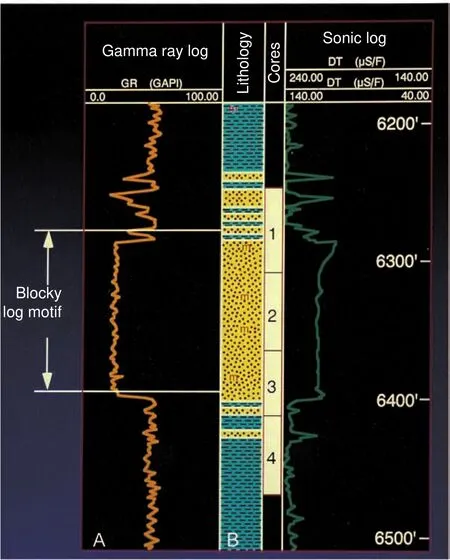
Of significance in the above compilation is the verti?cal facies model for deposits of high?density turbidity cur?rents (HDTC) with R1, R2, R3, S1, S2, and S3 internal divisions for sands and gravels in ascending order (Lowe,1982). This model was derived solely from the study of ancient rock record using outcrops. The primary attraction to this model in the petroleum industry is that it allows one to interpret ancient deep?water coarse sandstone and conglomerate deposits as turbidites (Mutti, 1992; Mulder,2011). Despite some recent cosmetic changes in nomen?clature (Tallinget al., 2012, their Figure 3) and other at?tempts to explain the basic turbidite facies models (Postmaet al., 2014, their Figure 13), there is absolutely no empiri?cal evidence (i.e., vertical sediment concentration profiles and grain?size measurements) for the existence of sandy and gravelly turbidity currents in modern oceans (Shan?mugam, 2012a). Thus far, none of the published claims of turbidity currents in modern environments (Heezen and Ewing, 1952; Inmanet al., 1976; Hayet al., 1982; Den?gler and Wilde, 1987; Normark, 1989; Piperet al., 1999;Khripounoffet al., 2003; Parsonset al., 2003; Xuet al.,2004; Crookshanks and Gilbert, 2008) has offered verifi?able empirical data on natural sandy and gravelly turbidity currents (Shanmugam, 2012a). Nor has anyone ever docu?mented the complete vertical Lowe Sequence with R1, R2,R3, S1, S2, and S3 divisions in modern deep?sea sands and gravels in DSDP and ODP sediment cores. When the very existence of natural sandy and gravelly turbidity currents is in doubt, outcrop?based facies models of HDTC (Lowe,1982; Postmaet al., 2014) are irrelevant in understanding the true origin of deep?water sandy deposits. In terms of fluid rheology and flow state, the concept of HDTC is a eu?phemism for sandy debris flows (Shanmugam, 1996). Un?like HDTC, however, sandy mass?transport processes and their deposits have been documented extensively by direct observations, underwater photographs, and remote sensing techniques in modern submarine canyons (Shepard and Dill, 1966), on modern submarine fan lobes (Gardneret al., 1996), and on modern continental rise (USGS, 1994).In short, any classification of deep-water medium-coarse sands and gravels as turbidites is dubious.
3.6 Excessive synonyms
Various classifications have given birth to a surplus of synonyms for mass?transport processes and their depos?its (Reiche, 1937; Varnes, 1958, 1978; Hsü, 1974; Nar?dinet al., 1979; Bates and Jackson, 1980; Nemec, 1990;Palanqueset al., 2006; Gaudinet al., 2006; Shanmugam,1996, 2006b; Camerlenghiet al., 2010; Tappin, 2010; Fes?taet al., 2014). Selected examples are:
· Landslide = slope movement = mass movement =mass transport = mass wasting
· Submarine landslide = megaturbidite = homogenite
· Mass-transport complex (MTC) = mass-transport de?posit (MTD) = submarine mass failure (SMF)
· Translational landslide = translational slip = block slide = glide = slide
· Rotational landslide = rotational slip = toreva block= slump
· Muddy debris flow = mud flow = cohesive debris flow = slurry flow = mass flow
· Debrite = olistostrome = sedimentary mélange
· Sandy debris flow = granular flow = cohesionless debris flow = density-modified grain flow = cohesionless liquefied sandflow = grain flow = mass flow = high-density turbidity current = hyperconcentrated flow = slurry flow =hybrid flow
· Flow slide = liquefaction slide
· Rock avalanche = debris avalanche = sturzstrom
· Sand fall = cascading densewater event = sand ava?lanche = grain flow = mass flow.
This excessive use of synonyms is, obviously, not only not necessary but even a reason for much confusion.
4 Recognition of the three basic types of MTD
Subaerial “l(fā)andslides” were recognized as early as in 186 BC in China (Li, 1989). Neveretheless, only during the past few decades, techniques of systematic recogni?tion and mapping have been developed (Brabb, 1991; Lee,2005). Also, Geographical Information Systems (GIS)have become an important part of databases on landslide research (e.g., Dikauet al., 1996). However, the ultimate recognition of individual types of MTD in the rock record must be based on principles of process sedimentology.
4.1 Process sedimentology
Process sedimentology is the key to recognizing the basic MTD types in core and outcrop. Sanders (1963)published the pioneering paper on process sedimentology entitled ‘Concepts of fluid mechanics provided by primary sedimentary structures’. The discipline is concerned with the detailed bed?by?bed description of siliciclastic (and calciclastic) sedimentary rocks for establishing the link between the deposit and the physics and hydrodynamics of the depositional process. Basic requirements, princi?ples, and methods of this discipline are: (1) a knowledge ofphysics, with emphasis onsoil mechanicsandfluid mechanics(Sanders, 1963; Brush, 1965), (2) the applica?tion of uniformitarianism principle, (3) the pragmatic, ac?curate, precise, and consistent description of the rock, (4)the preservation of absolute distinction between descrip?tion and interpretation, (5) the documentation of excruci?ating details in sedimentological logs, (6) the interpreta?tion of processes using exclusively primary sedimentary structures, (7) the mandatory consideration of alternative process interpretations, (8) the total exclusion of facies models, (9) the quantification of depositional facies, and(10) the routine use of common sense. A major problem in sedimentological studies is the failure to adopt the basic principles of process sedimentology, which has prompted lively debates on the deep?water petroleum?producing res?ervoirs of the Kutei Basin, Indonesia (Figure 1) (Dunham and Saller, 2014; Salleret al., 2006; Shanmugam, 2008a,2014a).
Of the three basic types of mass?transport processes,namely slides, slumps, and debris flows (Figure 7), the terms slide and slump are used for both a process and a deposit. The term debrite is used for deposit of a debris flow. The prefix ‘sandy’ is used for lithofacies that have grain size values greater than 0.06 mm (sand and gravel)and have concentration value equal to or above 20% by volume (Figure 7D). The three sandy SMTD types are em?phasized here because of their reservoir potential. Criteria for recognizing MTD and SMTD types in core and outcrop have been developed by integrating my rock description(Table 3) with published information by other researchers(Dott, 1963; Helwig, 1970; Johnson, 1970; Fisher, 1971;Hampton, 1972; Middleton and Hampton, 1973; Enos,1977; Dingle, 1977; Woodcock, 1976, 1979; Cook, 1979;Lowe, 1982; Maltman, 1987, 1994; Pickeringet al., 1989;Collinson, 1994). Numerous outcrop and core photographs of features associated with sandy slides, sandy slumps, and sandy debrites were published elsewhere (Shanmugam,2012a).
4.2 Slides
A slide is a coherent mass of sediment or a rigid body that moves along a planar glide plane and shows no inter?nal deformation (Figure 7A). Slides represent translational shear?surface movements. Such sliding movements are also common in glaciers (Easterbrook, 1999). Submarine slides can travel hundreds of kilometers on continental slopes. Long?runout distances of up to 810 km for slides have been documented for submarine MTD (Table 5).
Some of the best studied seismic examples of subma?rine MTD are in the area of the Storegga Slide on the mid?Norwegian continental margin (Solheimet al., 2005b).Even in these cases, the authors acknowledged the practi?cal difficulties in distinguishing slides from debrites on seismic profiles. This is because both slides and debritesexhibit homogeneous (i.e., transparent) to chaotic reflec?tions (Figure 3). In distinguishing slides from debrites,Solheimet al.(2005b) used additional criteria, such as the existence of a headwall as well as sidewalls. Similar problems of recognizing individual depositional facies(e.g., slides vs. debrites) on seismic profiles have been acknowledged by Tripsanaset al.(2008) and Twichellet al.(2009). In recognizing slides, McAdooet al.(2000)used bathymetry and GLORIA (Geological Long?Range Inclined Asdic) side?scan sonar data. But such large?scale images are unreliable for distinguishing the sliding mo?tion from flowing motion. These real-world examples re?veal the limitations of relying on seismic data for distin?guishing specific types of deep-water depositional facies.The solution is to examine the rocks directly by using core or outcrop.
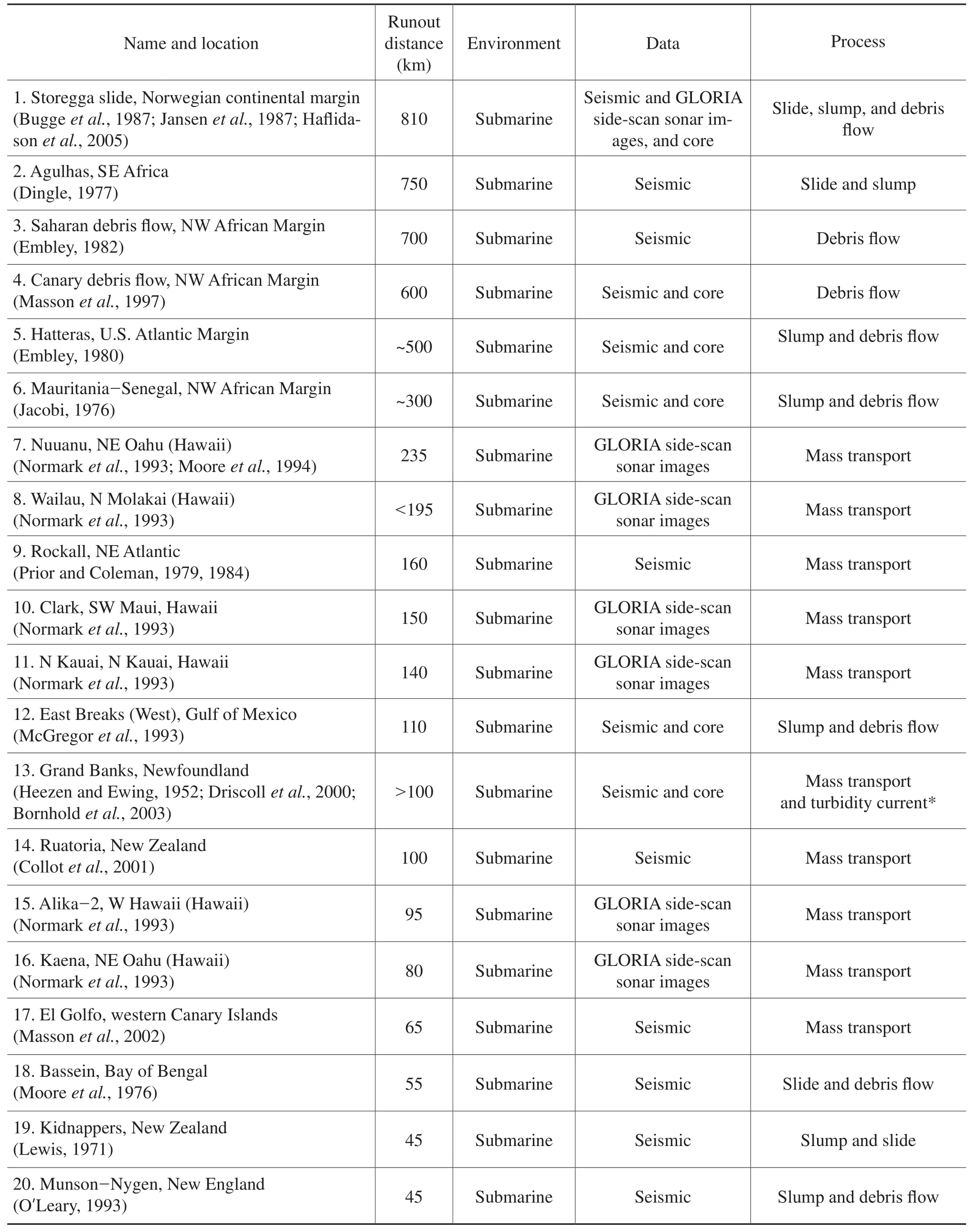
Table 5 Comparison of long?runout MTD on Earth (submarine and subaerial) with Venus, Iapetus, and Mars (extraterrestrial). The term “l(fā)andslide” was used to describe many of these examples by the original authors. Locations of selected examples are shown in Figure 1. Long?runout MTD provide empirical data for developing depositional models for deep?water sandstone petroleum reservoirs.The change in numbering is to reflect the change in type of environment (subaerial, submarine, and extraterrestrial). Compiled from several sources.
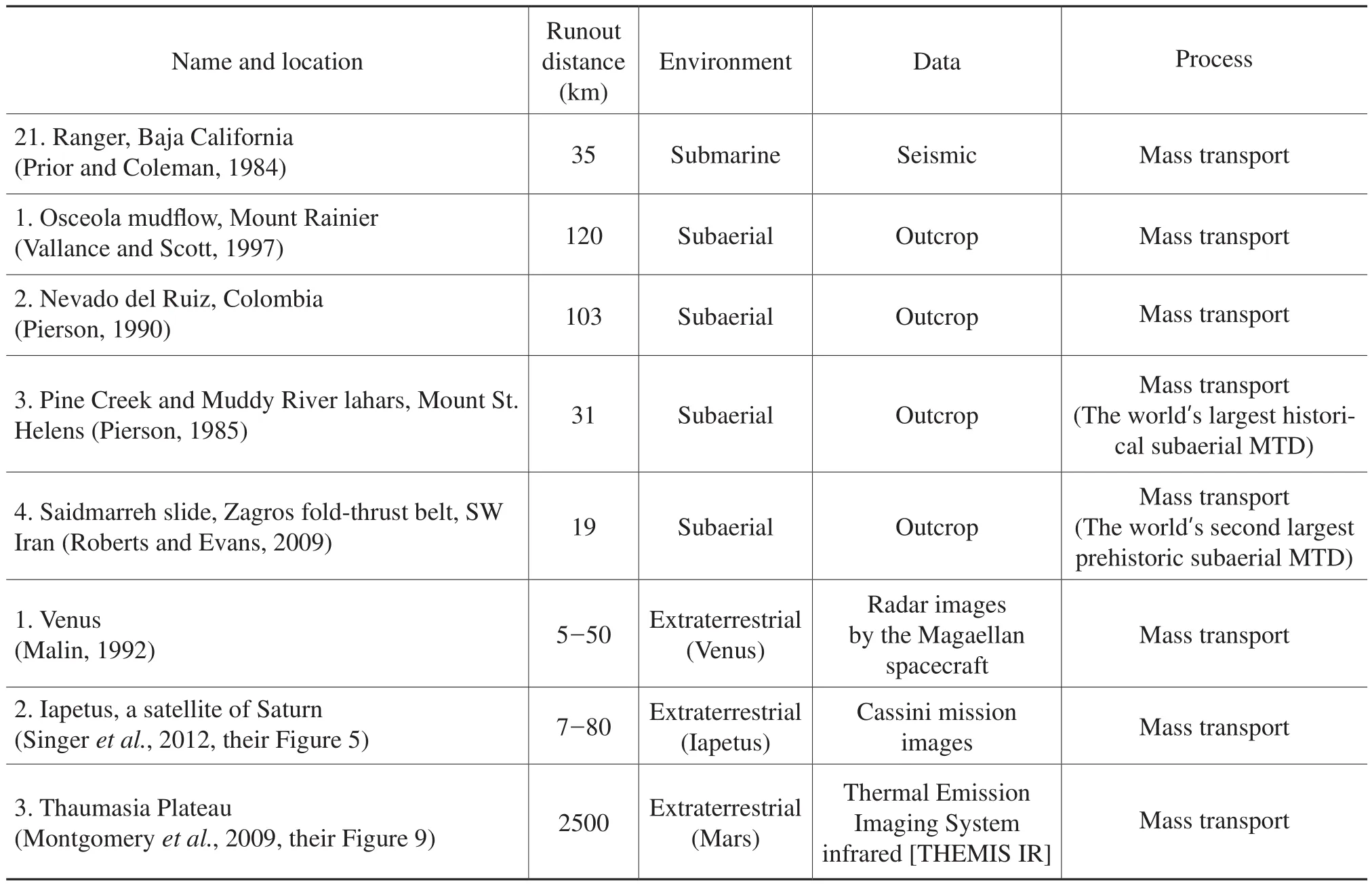
Table 5, continued
Slides are capable of transporting gravel and coarse?grained sand because of their inherent strength. General characteristics of slides are:
· Blocky log motif (Figure 9A). Cored interval of this log motif (Figure 9B) reveals complex internal features in core (Figure 10B)
· Primary basal glide plane or décollement (core and outcrop) (Figure 10B)
· Basal shear zone (core and outcrop) (Figure 10C)
· Secondary internal glide planes (core and outcrop)(Figure 10B)
· Preservation of original strata from the provenance region (Figure 11)
· Multiple internal layers within a single slide unit(Figure 11)
· Subaerial to shallow?water facies encased in deep?water host muddy facies (Figure 11)
· Associated slumps (Figure 11)
· Sheet?like geometry (Figure 11)
In submarine environments, slides tend to occur on con?tinental margins commonly near the shelf?slope breaks, in submarine canyons, and in fjords. However, long?runout slides may occur in basinal settings as well. Slides are commonly associated with triggering events such as earth?quakes, meteorite impacts, volcanic activities, glacial loading, sediment loading, cyclones, and tsunamis.
4.3 Slumps
A slump is a coherent mass of sediment that moves on a concave?up glide plane and undergoes rotational move?ments causing internal deformation (Figure 7A). Slumps represent rotational shear?surface movements. Slumps are capable of transporting gravel and coarse?grained sand be?cause of their inherent strength. General characteristics of slumps are:
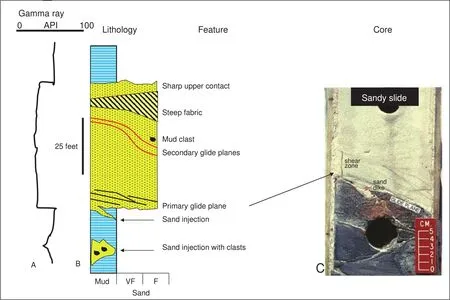
· Basal zone of shearing (core and outcrop)
· Slump folds (Helwig, 1970) interbedded with unde?formed layers (core and outcrop) (Figure 12)
· Irregular upper contact (core and outcrop)
· Chaotic bedding in heterolithic facies (core and out?crop)
· Rotated elongate grains (Maltman, 1987) (Micro?scopic)
· Steeply dipping and truncated layers (core and out?crop) (Figure 12)
· Associated slides (core and outcrop) (Figure 11)
· Chaotic facies in high-resolution seismic profiles.
In submarine environments, slumps tend to occur com?monly on slope settings.
4.4 Debrites
A debris flow is a sediment flow with plastic rheology and laminar state from which deposition occurs through freezingen masse. The terms debris flow and mass flow are used interchangeably because each exhibits plastic flow behavior with shear stress distributed throughout the mass (Nardinet al., 1979). In debris flows, inter-granular movements predominate over shear?surface movements.Although most debris flows move as incoherent mass,some plastic flows may be transitional in behavior between coherent mass movements and incoherent sediment flows(Marret al., 2001). Debris flows may be mud-rich (i.e.,muddy debris flows), sand-rich (i.e., sandy debris flows),or mixed types.
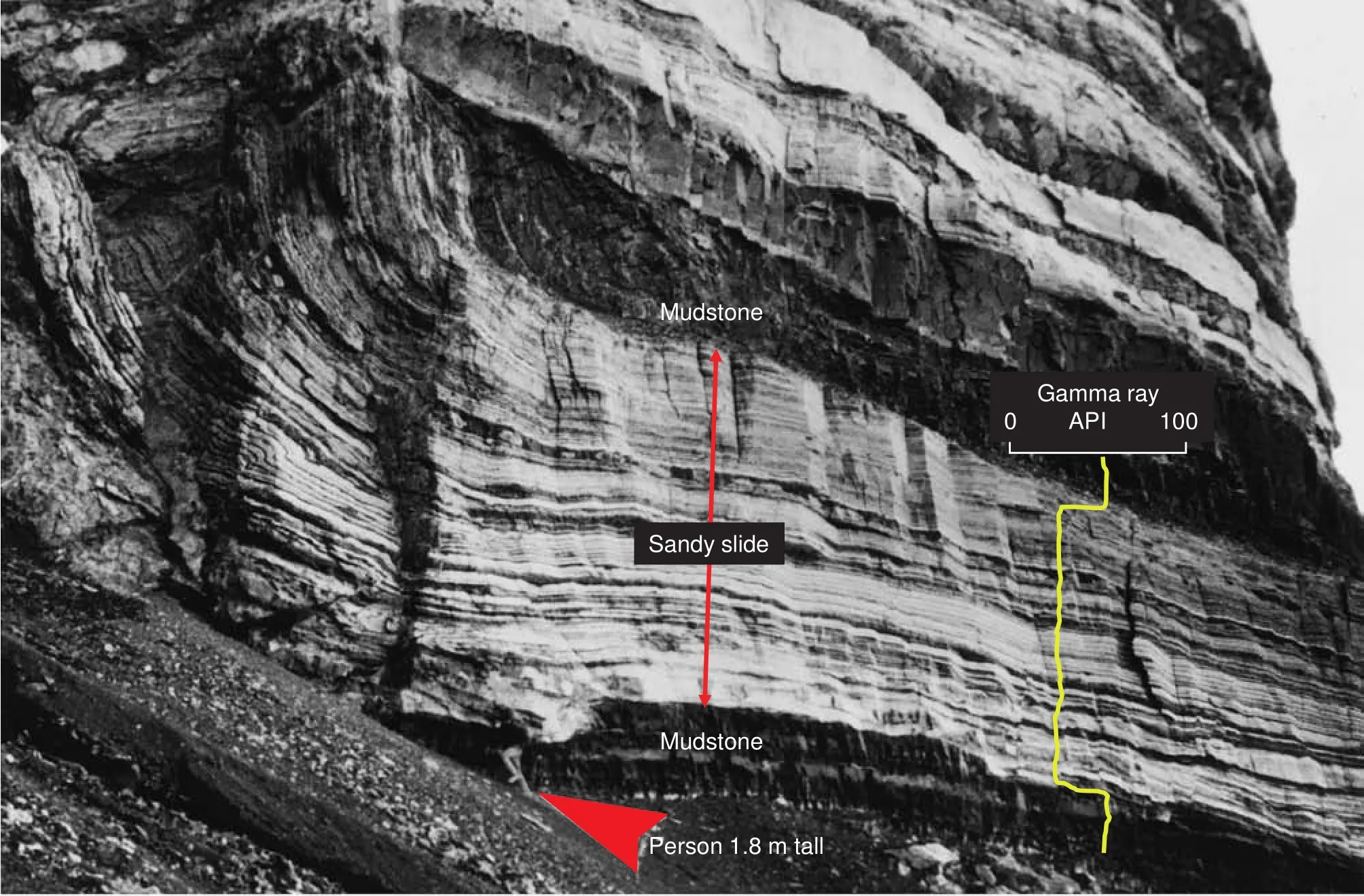
Figure 11 Outcrop photograph showing sheet?like geometry of an ancient sandy submarine slide (1000 m long and 50 m thick) en?cased in deep?water mudstone facies. Note the large sandstone sheet with rotated/slumped edge (left). Person (arrow): 1.8 m tall. Note multiple internal layers of the slide unit representing pre?transport disposition of strata in the provenance region. A hypothetical gamma ray log showing blocky motif for the sandy slide is inserted to illustrate how this sandy unit might appear in the subsurface on wireline logs (compare with Figure 10A and Figure 24A). Ablation Point Formation, Kimmeridgian (Jurassic), Alexander Island, Antarctica.Photo courtesy of D. J. M. Macdonald. From Macdonald et al. (1993). With permission from GSA.
For the first time, to understand mechanics of sandy debris flows (SDF) and their deposits and to distinguish them from turbidites, a Mobil-funded experimental flume study was carried out at St. Anthony Falls Laboratory(SAFL), University of Minnesota (1996-1998). Experi?ments clearly showed that SDF transport coarse sediment as plastic laminar flow (basal layer), emplacing massive sands (Shanmugam, 2000; Marret al., 2001). Debris flows are capable of transporting gravel and coarse?grained sand because of their inherent strength. In contrast, turbidity currents cannot transport coarse sand and gravel in turbu?lent suspension (Shanmugam, 2012a). These experimental studies yielded diagnostic depositional features that are the key to recognizing deep?water massive sands as sandy de?brites (Shanmugam, 2000).
General characteristics of muddy and sandy debrites are:
· Floating or rafted mudstone clasts near the tops of sandy beds (core and outcrop) (Figure 13); clasts can also be dispersed throughout the sediment interval
· Floating armored mudstone balls in sandy matrix(core and outcrop)
· Planar clast fabric (core and outcrop) (Figure 13).Planar clast fabric can be used to infer laminar flow con?ditions (Fisher, 1971; Enos, 1977; Shanmugam and Ben?edict, 1978), a flow state common to debris flow.
· Projected clasts (core and outcrop) (Shanmugam and Benedit, 1978)
· Imbricate clasts in outcrop (van Loon, 1972; Shan?mugam and Benedict, 1978; Brown and Bell, 2007) and in experiment (Major, 1998)
· Brecciated mudstone clasts in sandy matrix (core and outcrop) (Figure 12)

Figure 12 Summary of sedimentological features associated with sandy slumps and associated debrites observed in core and outcrop. These features, compiled from real?world examples, are useful in recognizing MTD types in the rock record. From Shan?mugam et al. (1995). With permission from AAPG.
· Inverse grading, normal grading, inverse to normal grading, and absence of any grading of matrix (core and outcrop)
· Floating quartz granules in fine-grained sandy matrix(core and outcrop), suggesting flow strength (Shanmugam,2012a)
· Pockets of gravels in sandy matrix (core and outcrop)
· Preservation of delicate mud fragments with planar fabric in sandy matrix (core and outcrop). Delicate features and constituents have been cited as evidence of laminar flow in debris-flow deposits (Enos, 1977; Johnson, 1970).
· Irregular and sharp upper contacts (core and outcrop)are considered evidence for deposition byen massefreez?ing of flows with plastic rheology (i.e., flow strength).
· Side?by?side occurrence of garnet granules (density:3.5-4.3) and quartz granules (density: 2.65) (core and out?crop), indicating flow strength (Shanmugam, 2012a)
· Lenticular to sheet in geometry
In submarine environments, debrites tend to occur both on slope and basinal settings. Debrites are also common in submarine canyons. Debrites are commonly associated with triggering events such as earthquakes, volcanic erup?tions, monsoonal floods, cyclones, and tsunamis.
5 Triggering mechanisms
A critical analysis of types of triggering mechanisms is important in understanding the timing of sediment failures that control emplacement of deep?water reservoirs. In the petroleum industry, most deep?water sands are believed to be deposited during periods of sea?level lowstands (Figure 19A) (Vailet al., 1991). However, such conceptual models are not supported by empirical data (Shanmugam, 2008b,2012a). Because deep?water SMTD constitute important petroleum reservoirs worldwide (Table 3), this topic is per?tinent in this review.
A triggering mechanism is defined here as the primary process that causes the necessary changes in the physical,chemical, and geotechnical properties of the soil, which results in the loss of shear strength that initiates the sedi?ment failure and movement. Commonly, triggering pro?cesses are considered “external” with respect to the site of failure. Wieczorek and Snyder (2009, p. 245), for ex?ample, state that “The term landslide trigger refers specifically to an external stimulus,such as intense rainfall,rapid snowmelt,earthquake,volcanic eruption,or stream or coastal erosion.These stimuli initiate an immediate or near?immediate landslide movement by rapidly increasing shear stresses or porewater pressures,by ground acceleration due to seismic activity,by removing lateral support,by reducing the strength of slope materials,or by initiating debris?flow activity.”
In continental margins, several triggering mechanisms may work concurrently or in tandem (e.g., earthquake?triggered tsunamis). Sowers (1979) articulated the chal?lenge of identifying the single mechanism that is solely responsible for the failure as follows: “In most cases,several‘causes’exist simultaneously;therefore,attempting to decide which one finally produced failure is not only difficult but also technically incorrect.Often the final factor is nothing more than a trigger that sets a body of earth in motion that was already on the verge of failure.Calling the final factor the cause is like calling the match that lit the fuse that detonated the dynamite that destroyed the building the cause of the disaster.”
5.1 Classification based on duration
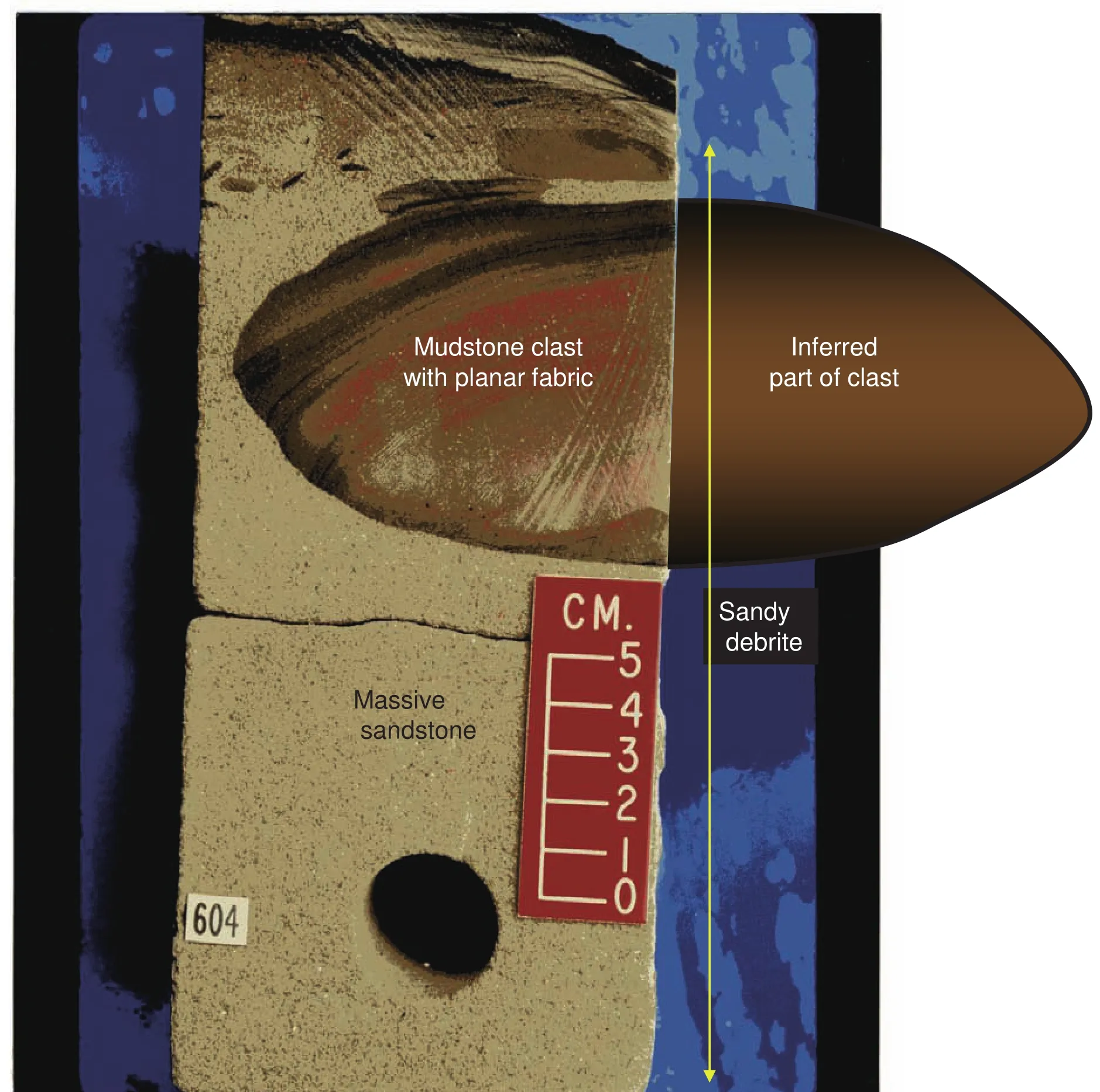
Figure 13 Core photograph of a massive fine-grained sandstone unit showing a large floating mudstone clast (above the scale). Note planar clast fabric (i.e., long axis of clast is aligned parallel to bedding surface), revealed by the inferred part of the clast, suggesting deposition from a laminar sandy debris flow. Note the occurrence of other mudstone clasts of different sizes immediately adjacent to the large clast. Also note sharp and irregular upper bedding contact (top of photo). Such features are indicative of flow strength and deposition from freezing of laminar plastic flows (Enos, 1977; Shanmugam and Benedict, 1978; Fisher, 1971). Paleocene, North Sea.Modified after Shanmugam (20012a). With permission from Elsevier.
Although more than one triggering mechanism can cause a single process (e.g., debris flow) at a given site,there are no objective criteria yet to distinguish either the triggering mechanism or the transport process from the depositional record (Shanmugam, 2006b, 2012b; Mulderet al., 2011). This is because what is preserved in the de?posit reflects the final moment of deposition, not transport(Middleton and Hampton, 1973). During the long trans?port history, a sediment-gravity flow can and does undergo flow transformation (Fisher, 1983; Shanmugam, 1996;Tallinget al., 2007). For example, sediment of a turbid?ite bed on the seafloor could have been transported as a debris flow and underwent flow transformation into a tur?bidity current at the time of deposition (see experiments by Hampton, 1972). Therefore, one cannot interpret trans?port mechanism from the depositional record using either seismic data or core data. Nevertheless, an understanding of different triggering mechanisms is necessary in evalu?ating sediment failures (Locat and Lee, 2005; Massonet al., 2006; Feeley, 2007; Piperet al., 2012a). There are at least 21 triggering mechanisms that can initiate sediment failures in subaerial and submarine environments on Earth(Table 6). These mechanisms are grouped into three ma?jor categories based on their duration of activity (Table 6):(1) short?term events that last for only a few minutes to several hours, days or months (e.g., earthquakes, volcanic eruptions, meteorite impacts, tsunamis, tropical cyclones,monsoon floods,etc.), (2) intermediate?term events that last for hundreds to thousands of years (e.g., tectonic events, glacial maxima and loading, depositional loading,gas hydrate decomposition,etc.), and (3) long?term events that last for thousands to millions of years, such as low?stands of sea level (Shanmugam, 2012a, 2012b). Conceiv?ably, some intermediate?term events may last for a longer duration. The point here is that short?term events and long?term events are markedly different in their duration.
Br?nnimann (2011) has recognized seven triggering mechanisms associated with hydrogeology: (1) suction,(2) rising pore?water pressure, (3) seepage forces, (4) inner erosion, (5) liquefaction, (6) over pressure, and (7) mecha?nisms related to high plasticity. Although these processes are important in affecting slope stability, they are not con?sidered here as principal triggering mechanisms, with the exception of groundwater seepage (Table 6). The reason is that the excess pore?water pressure, for example, is a pi?ezometric responsein situto external forces, such as rain?fall, glacial loading, human activity,etc.Furthermore, the in?situ lithologic properties are closely tied to controlling pore?water pressures and related sediment failures. These complications are evident in the 1979 sediment failure that occurred at the Nice international airport in southern France. The 1979 Nice incident has been attributed to a combination of both external and internal factors (Danet al., 2007, their Figure 20). These complications are illus?trated in Figure 14.
1) Internal lithologic factor (Figure 14A): The presence of a high?permeability sand layer, which served as a fresh?water conduit, was significant in increasing the sensitivity of the surrounding clay by leaching.
2) External human factor (Figure 14B): The interna?tional airport was constructed on a platform enlarged by land-filling material. The 1979 expansion of the airport apparently resulted in local loading beneath the embank?ment, which was responsible for softening of the mechani?cal properties of the sensitive clay layer and for its ‘creep?ing’ movement.
3) External meteorological factor (Figure 14C): Intense rainfall over the entire Var drainage basin and the Nice coast in southern France two weeks before the 1979 event was vital in pre?conditioning the site for a potential slope failure.
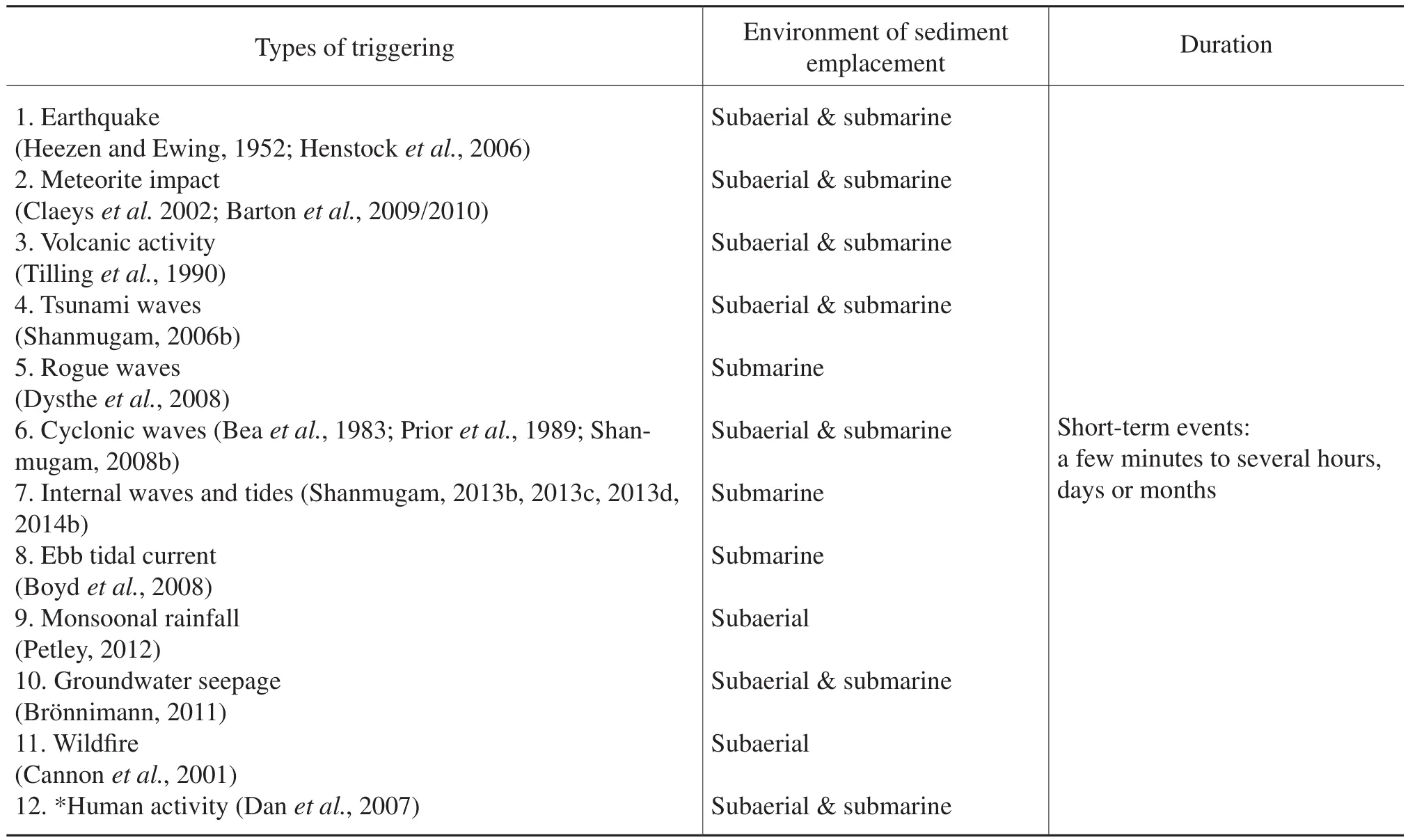
Table 6 Types and duration of triggering mechanisms of sediment failures. Compiled from several sources. Updated after Shan?mugam (2012a, 2012b, 2013a). The change in numbering is to reflect the change in duration of triggering events.
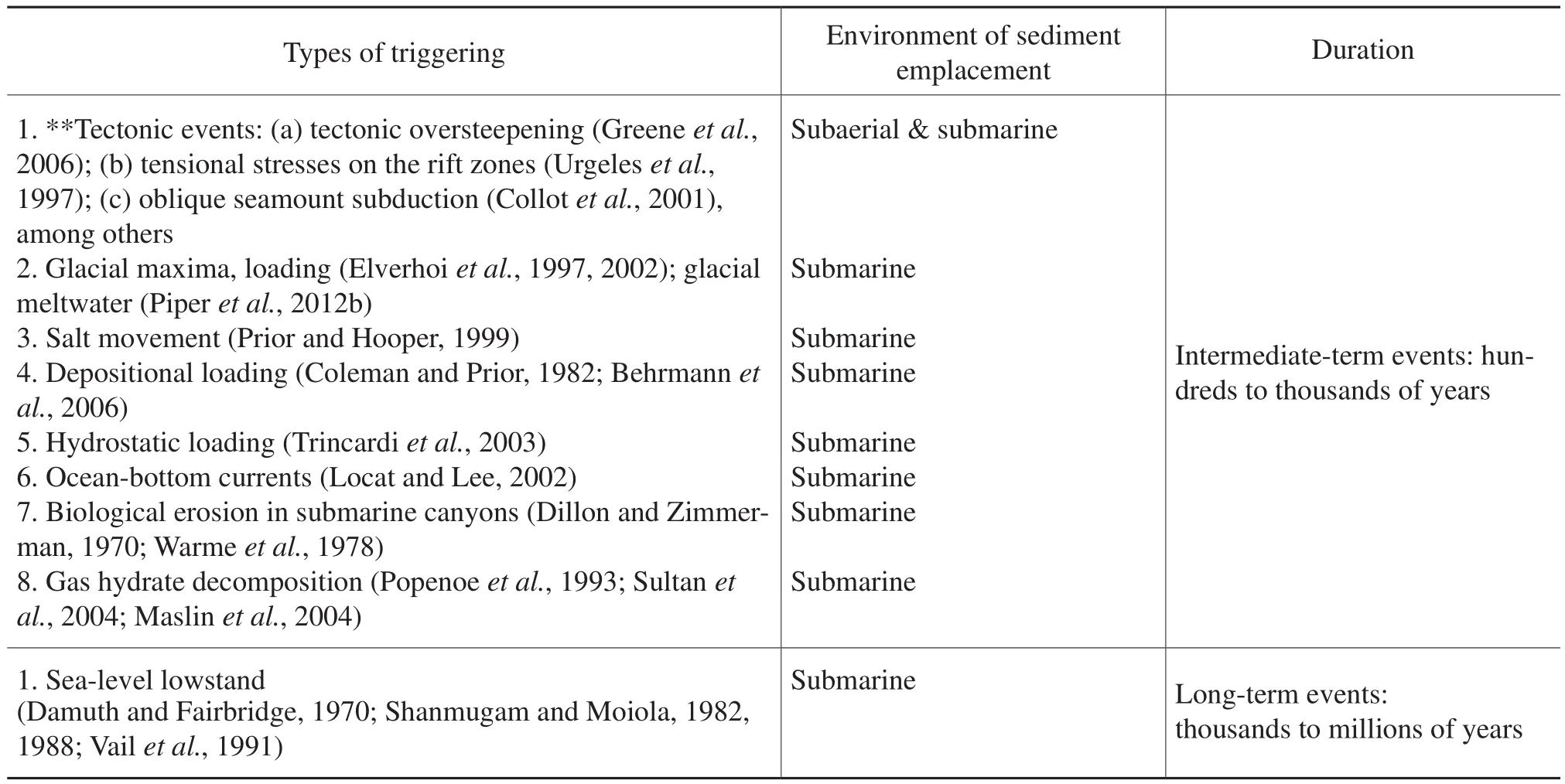
Table 6, continued
4) Internal geotechnical factor (Figure 14C): After a pe?riod of rainfall, seepage of fresh ground water through the high?permeability sand layer into the surrounding clay had caused an increase in the pore?water pressure, which led to the reduction of the effective shear strength that resulted in the Nice sediment failure on October 16, 1979. As a result, a part of the airport extension, which was built to be a harbor, collapsed into the Mediterranean Sea. Although the pore?water pressure was the last factor involved in a long?line of processes that caused the sediment failure, it was not the sole triggering mechanism.
5.2 Sea-level lowstand model
In the petroleum industry, the sea?level lowstand model is the perceived norm for explaining the timing of deep?water sands. Salleret al.(2006), for example, attributed the timing of reservoir sands in the Kutei Basin in the Makassar Strait, Indonesian Seas (Figure 1, black trian?gle) to a lowstand of sea?level. Nevertheless, the location of the Kutei Basin (Figure 1, black triangle) is frequently affected by earthquakes, volcanoes, tsunamis, tropical cy?clones, monsoon floods, the Indonesian throughflow, and M2 baroclinic tides (M2 represents the main lunar semidi?urnal tidal constituent with a period of 12.42 h) (see Shan?mugam, 2008a, 2012a, 2014a). These daily activities of the solar system (e.g., earthquakes, meteorite impacts, tsu?namis, cyclonic waves,etc.) do not come to a halt during sea?level lowstands. In tectonically and oceanographically tumultuous locations, such as the Indonesian Seas, the short?term events are the primary triggering mechanisms of deepwater sediment failures and they occur in a matter of hours or days during long periods of both highstands and lowstands (Shanmugam, 2008b).
Deep?water petroleum?bearing Paleocene sand (100 m thick) of the Lower Tertiary Wilcox trend, which oc?curs above the K-T boundary in the BAHA #2 wildcat test well, has been interpreted as “l(fā)owstand” turbidite fan in the northern Gulf of Mexico (Meyeret al., 2007, their Figure 3). However, because of the opportune location of the Lower Tertiary Wilcox trend and the stratigraphic posi?tion and age, the drilled Paleocene sand could alternatively be attributed to the Chicxulub impact and related seismic shocks and tsunamis (Figure 15). Tsunami?related deposi?tion on continental margins has been discussed by Shan?mugam (2006b). Contrary to the conventional wisdom on the timing of deposition of deep?water sands during peri?ods of sea?level lowstands, earthquakes, meteorite impacts(Bartonet al., 2009/2010), tsunamis (Figure 16), tropical cyclones (Figure 17), initiate SMTD suddenly in a matter of hours or days during the present sea?level highstand.However, there are no established criteria to distinguish SMTD associated with tsunamis (Figure 18) from those associated with tropical cyclones (Shanmugam, 2012b).This is an important area of future research.
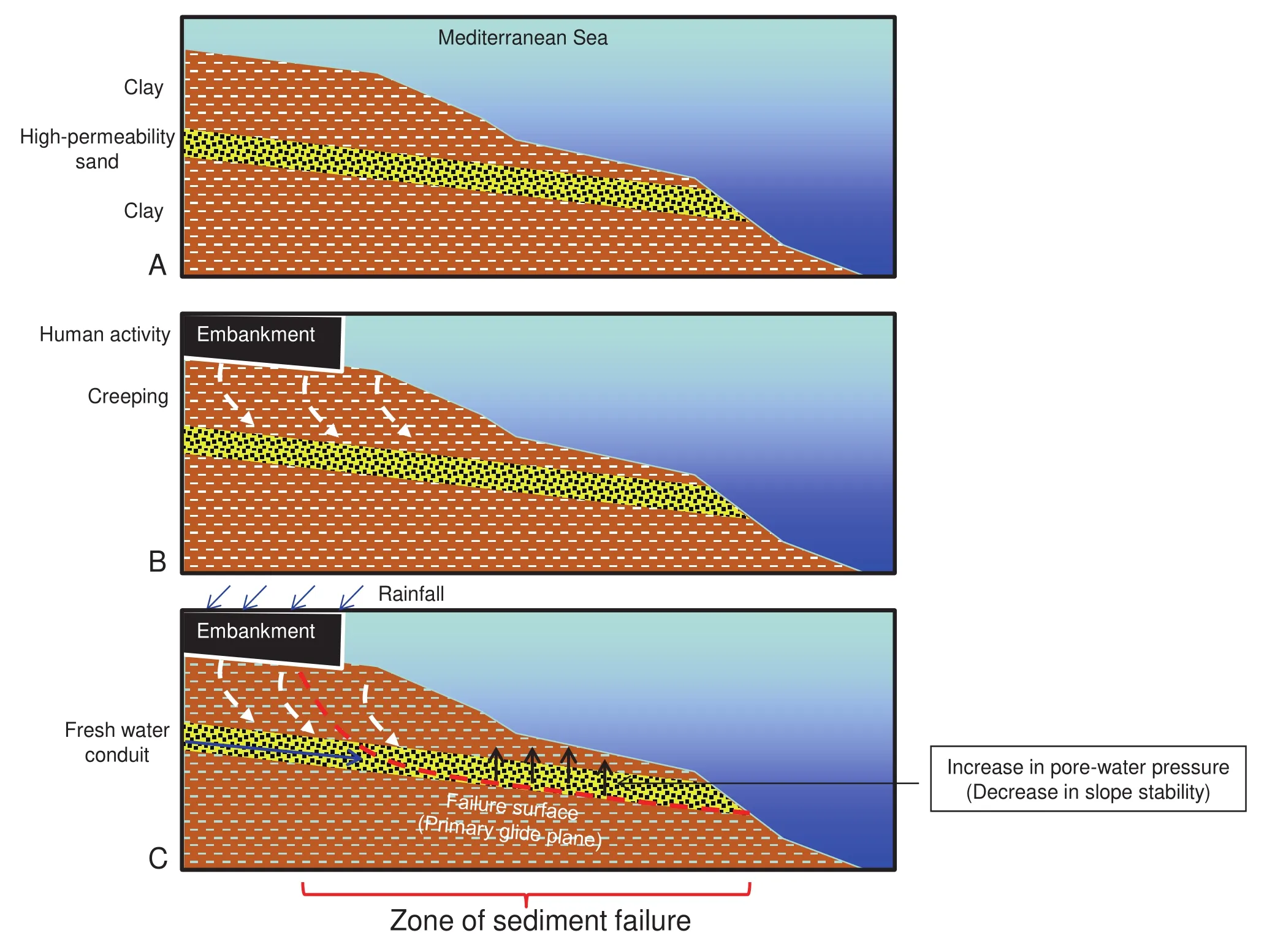
The Hurricane Hugo (Hubbard, 1992), which passed over St. Croix in the U.S. Virgin Islands on 17 Septem?ber 1989, had generated winds in excess of 110 knots(204 km·h-1, Category 3 in the Saffir-Simpson Scale) and waves 6-7 m in height. In the Salt River submarine can?yon (>100 m deep), offshore St. Croix, a current meter measured net down?canyon currents reaching velocities of 2 m·s-1and oscillatory flows up to 4 m·s-1. Hurricane Hugo had caused erosion of 2 m of sand in the Salt River Canyon at a depth of about 30 m. A minimum of 2 million kg of sediment were flushed down the Salt River Canyon into deep water (Hubbard, 1992). The transport rate as?sociated with Hurricane Hugo was 11 orders of magnitude greater than that measured during fair?weather period. In the Salt River Canyon, much of the soft reef cover (e.g.,sponges) had been eroded away by the power of the hur?ricane. Debris composed of palm fronds, trash, and pieces of boats found in the canyon were the evidence for storm?generated debris flows. Storm-induced sediment flows during the present highstand have also been reported in a submarine canyon off Bangladesh (Kudrasset al., 1998),in the Capbreton Canyon, Bay of Biscay in SW France(Mulderet al., 2001), in the Cap de Creus Canyon in the Gulf of Lions (Palanqueset al., 2006), and in the Eel Can?yon, California (Puiget al., 2003), among others. These alternative real?world highstand possibilities are often overlooked because of the prevailing mindset of the sea?level lowstand model.
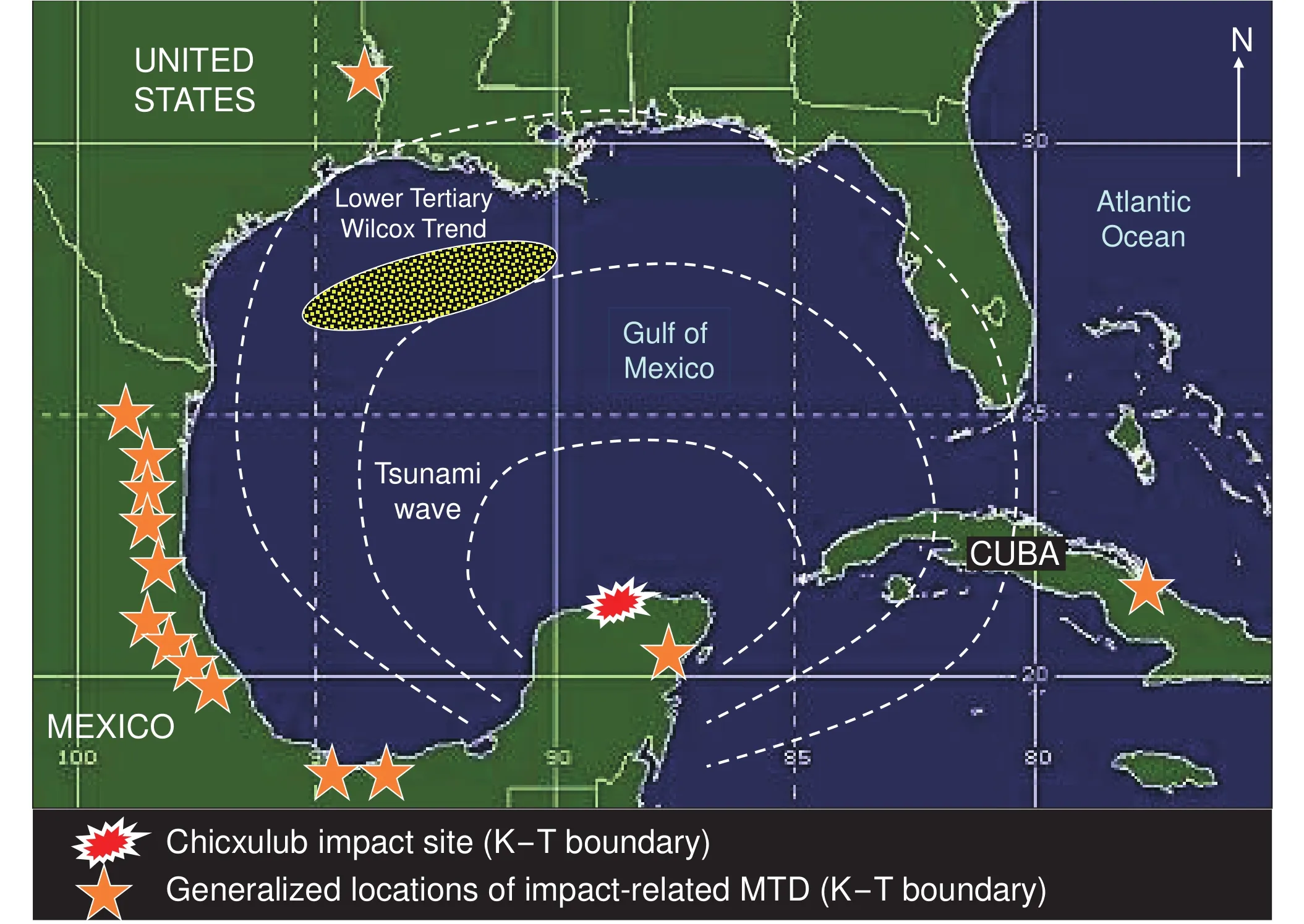
The reasons for sand deposition in the deep sea dur?ing highstands are: (1) narrow shelf width and headward erosion of submarine canyons (Schwalbachet al., 1996);(2) increasing monsoon intensity (Goodbred, 2003) and related deep?water sedimentation (Weberet al., 1997);(3) sediment bypassing of the shelf (Kuehlet al., 1989);(4) rates of delta progradation and formation of highstand shelfedge deltas (Burgess and Hovius, 1998); (5) high sediment supply (Carvajal and Steel, 2006); (6) cyclones(Kudrasset al., 1998; Shanmugam, 2008b); and (7) tsu?namis (Shanmugam, 2006a, 2006b). In discussing the La Jolla highstand fan in the California borderland, Covaultet al.(2007, p. 786) state, “Contrary to widely used sequence stratigraphic models,lowstand fans are only part of the turbidite depositional record,and this analysis re-veals that a comparable volume of coarse clastic sediment has been deposited in California borderland deep-water basins regardless of sea level.”
At the rate of 10 cyclones per year during 1891-2000 in the Bay of Bengal (Mascarenhas, 2004), 200,000 cy?clones would have occurred during the present highstand(Figure 19). Empirical data also show that 140,000 tsu?namis would have occurred during the present highstand interval in the Pacific Ocean alone (Figure 19). In other words, sand deposition can and does occur during peri?ods of sea?level highstands (Figure 19). For these reasons,the lowstand model is obsolete for explaining the trigger?ing of deep?water SMTD worldwide (Shanmugam, 2007,2008b).
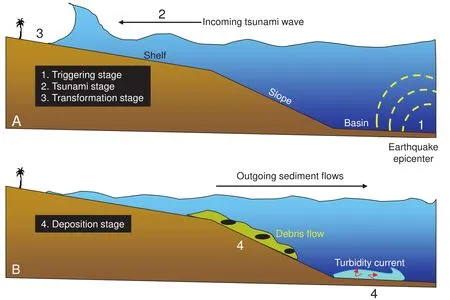
Figure 16 Depositional model showing the link between tsunamis and deep?water deposition. A-1-Triggering stage in which earth?quakes trigger tsunami waves. 2-Tsunami stage in which an incoming (up?run) tsunami wave increases in wave height as it approaches the coast. 3-Transformation stage in which an incoming tsunami wave erodes and incorporates sediment, and transforms into sediment flows; B-4-Deposition stage in which outgoing (backwash) sediment flows (i.e., debris flows and turbidity currents) deposit sediment in deep?water environments. Suspended mud created by tsunami?related events would be deposited via hemipelagic setting. After Shanmugam (2006b). With permission from SEPM.
In light of the existing wealth of empirical data associ?ated with tsunamis, tropical cyclones, meteorite impacts,earthquakes,etc., future petroleum exploration cannot af?ford to continue the application of obsolete sea?level mod?els in understanding the timing and emplacements of deep?water sands (Shanmugam, 2007).
6 Long-runout mechanisms
An understanding of long?runout mechanisms is impor?tant not only for academic reasons, but also for economic reasons. For example, long?runout MTD (Table 5) pro?vide empirical data for developing predictive depositional models for deep?water sandstone petroleum reservoirs in the subsurface.
6.1 Basic concept
The basic premise of long?runout MTD is that they travel further than the distance predicted by simple fric?tional models. Heim’s (1932) study of the subaerial ‘Elm Slide’ in the Swiss Alps has been the source of the fol?lowing basic equations for understanding the mobility of MTD:
1)H/L= tanφ, whereHrepresents the vertical fall height,Lrepresents the runout distance, andφis the Cou?lomb angle of sliding friction (e.g., Griswold and Iverson,2008).
2)H/Lα 1/V, whereVis the initial volume of the mov?ing mass (e.g., McEwen, 1989).
3)H/L= 1, whereLis the normal?runout distance (Fig?ure 20A) (e.g., Collins and Melosh, 2003).
4)H/L≤ 1, whereLis the long?runout distance (Figure 20B) (e.g., Hamptonet al., 1996).
Although there are many documented cases of long?runout MTD in both subaerial (Table 5) and submarine(e.g., submarine slides in Hawaii with more than 200 km of runout distances, Mooreet al., 1989) environments withrunout distances measuring up to 100 times their vertical fall height and high speeds of up to 500 km·h-1(Martins?en, 1994), the geologic community was reluctant to accept mechanisms that attempted to explain MTD that travel farther and faster than expected. A major turning point on the skepticism over long?runout MTD occurred on May 18, 1980 when the Eruption of Mount St. Helens in the U.S. generated impressive long runout subaerial MTD that were captured on videotapes (see The Learning Channel,1997).
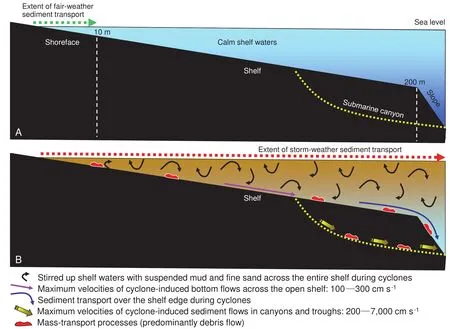
6.2 Subaerial environments
There are at least 20 potential mechanisms that could explain the mechanical paradox of long?runout MTD (Ter?zaghi, 1950; Brunsden, 1979; Schaller, 1991, among oth?ers). Selected examples of subaerial mechanisms are:
1) Lubrication by liquefied saturated soil entrained dur?ing transport (Heim, 1882; Hungr and Evans, 2004)
2) Dispersive pressure in grain flows (Bagnold, 1954)
3) Fluidization by entrapped air (Kent, 1966)
4) Cushion of compressed air beneath the slide (Shreve,1968)
5) Fluidization by dust dispersions (Hsü, 1975), akin to grain flows (Bagnold, 1954)
6) Spontaneous reduction of friction angle at high rates of shearing (Scheidegger, 1975; Campbell, 1989)
7) Vaporization of water at the base and related excess pore?water pressure (Goguel, 1978)
8) Frictional heating along a basal fluid-saturated shear zone and related rise in pore?water pressure (Voight and Faust, 1982; Goren and Aharonov, 2007)
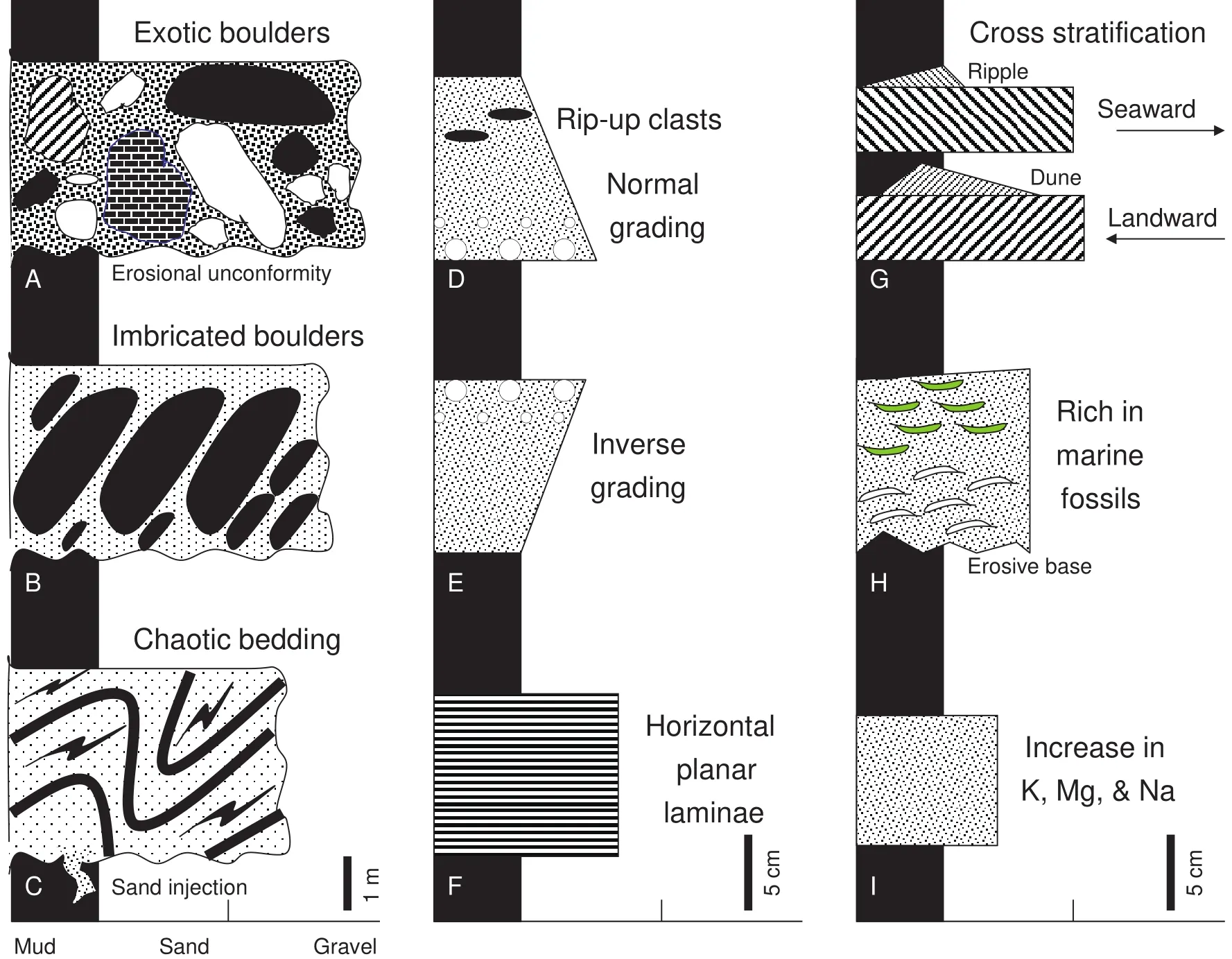
Figure 18 Published sedimentological features claimed to be associated with tsunami?related deposits by other authors. These fea?tures are also claimed to be associated with cyclone?related deposits by different authors. See review by Shanmugam (2012b). With permission from Springer Copyright Clearance Center’s RightsLink: Licensee: G. Shanmugam. License Number: 3570270421988.License Date: February 15, 2015.
9) Self?lubrication by frictionally generated basal melt layers (Erismann, 1979; De Blasio and Elverh?i, 2008;Weidinger and Korup, 2009)
10) Acoustic fluidization (Melosh, 1979)
11) Mechanical fluidization or inertial grain flow(Davies, 1982)
12) Fluidization by volcanic gases (Voightet al., 1983).
13) Excess pore?water pressure (Cruden and Hungr,1986; Iverson, 1997)
14) Self-lubrication by granular flows acting as basal shear zone (Cleary and Campbell, 1993)
15) Seismic energy released during meteorite impacts,proposed for Mars (Akerset al., 2012), is also applicable to Earth.
6.3 Submarine environments
Submarine environments with long?runout MTD have been broadly grouped into five types: (1) fjords, (2) ac?tive river deltas on the continental margin, (3) submarine canyon?fan systems, (4) open continental slopes, and (5)oceanic volcanic islands and ridges by Hamptonet al.(1996). To this list, a sixth type ‘glacially-influenced con?tinental margins’ (Elverh?iet al., 1997) needs to be added.Submarine MTD with long?runout distances of over 100 km commonly occur on slopes of less than 2° on the U.S.Atlantic Continental Slope (Figure 5). Several potential mechanisms are available for explaining long?runout sub?marine MTD over low?angle slopes:
1) Hydroplaning (Mohriget al., 1998)
2) Excess pore?water pressure (Pierson, 1981; Geeet al., 1999)
3) Elevated gas pressure (Coleman and Prior, 1988)
4) Dispersive pressure in grain flows (Bagnold, 1954;Noremet al., 1990)
5) Self-lubrication by granular flows acting as basal shear zone (Cleary and Campbell, 1993)
6) Self?lubrication at the base of gas?hydrate stability window that coincides with the base of MTD (Buggeet al., 1987; Cochonatet al., 2002).
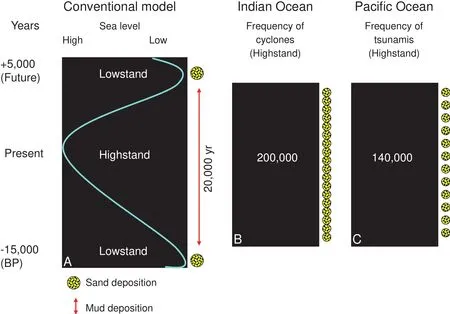
Figure 19 A-Conventional sea?level model showing deep?water deposition of sand during periods of lowstand and deposition of mud during periods of highstand. The present highstand is estimated to represent a period of 20,000 years. BP = before present;B-200,000 cyclones are estimated to occur during the present highstand in the Bay of Bengal (Indian Ocean) and in the Atlantic Ocean; C-140,000 tsunamis are estimated to occur during the present highstand in the Pacific Ocean. After Shanmugam (2008b). With permission from AAPG.
7) Flow transformation (Tallinget al., 2007)
8) Seismic energy released during meteorite impacts,proposed for Mars (Akerset al., 2012), is also applicable to Earth.
Of various mechanisms listed above, the hydroplan?ing concept (Mohriget al., 1998) has gained acceptance(McAdooet al., 2000; Shanmugam, 2000; Marret al.,2001; Elverh?iet al., 2002; Ilstadet al., 2004; De Blasioet al., 2006). Nevertheless, the hydroplaning mechanism is inapplicable to explaining long-runout debris flows in subaerial and extraterrestrial environments.
6.4 Extraterrestrial environments
Analogous to subaerial and submarine environments on Earth, there are numerous published examples of long?runout MTD on other planets of the Solar System (Table 5). Although submarine MTD show much longer runout distances than those of subaerial MTD on Earth, the long?est runout distance of 2500 km has been documented for an extraterrestrial MTD on Mars (Montgomeryet al.,2009, their Figure 9). The following mechanisms have been offered for explaining long?runout MTD on extrater?restrial environments:
1) Self?lubrication by released groundwater, wet debris,or mud (Lucchitta, 1979, 1987)
2) Aqueous pore?pressure support (Harrison and Grimm, 2003)
3) Continental?scale salt tectonics coupled with over?pressured fluids (Montgomeryet al., 2009)
4) Movement on ice (De Blasio, 2011)
5) Movement on evaporitic salt (De Blasio, 2011)
6) Friction reduction during flash heating (Singeret al.,2012)
7) Seismic energy released during meteorite impacts(Akerset al., 2012). Similar explanations were offered previously for landslides on the Moon (Guest, 1971; How?ard, 1973).
6.5 H/L ratio problems
Although theH/Lmodel has been influential for nearly a century, many problems still remain.
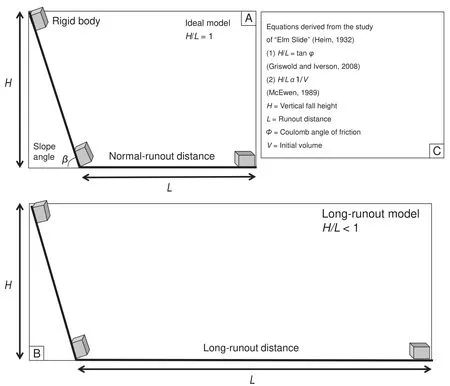
Figure 20 Conceptual models showing sliding movement of a rigid body in subaerial environments. A-An ideal model in which the predicted runout length (L) is equal to vertical fall height (H) (e.g., Collins and Melosh, 2003); B-Long?runout model in which the runout length (L) exceeds the vertical fall height (e.g., Hampton et al., 1996); C-Basic equations derived from the work of Heim(1932) on the ‘Elm Slide’ in the Swiss Alps.
1) Because the original work by Heim (1932) was written in German, there have been differences of opin?ion among later workers as to the meaning of the German nomenclature used by Heim to describe the type of mo?tion, ranging from sliding (Shreve, 1968) to flowing (Hsü,1975).
2) TheH/Lratios for submarine MTD are lower(0.001-0.3, Hamptonet al., 1996, their Table 5) than those for subaerial counterparts (1.6-21, Ritteret al., 1995). The model underestimates the extent of runout distance (L) for water-saturated debris flows (Iverson, 1997; Griswold and Iverson, 2008) and if the volumes of moving mass ex?ceed about 106 m3(Heim, 1932; Hsü, 1975; Scheidegger,1973). Also, the model does not take into account the ef?fect of runout?path topography on the distal or lateral lim?its of inundation (Griswold and Iverson, 2008).
3) At a given value ofH/L, the Martian MTD are typi?cally about 50 to 100 times more voluminous than the ter?restrial counterparts (McEwen, 1989). However, there is no universally accepted physical basis for explaining the equationH/Lα 1/V(Dade and Huppert, 1998).
4) Dade and Huppert (1998) have usedL/Has a meas?ure of the efficiency of MTD movement, which is the in?verse of the friction coefficient (H/L).
5) On Earth, submarine MTD are much larger in size than subaerial MTD (Hamptonet al., 1996), and subma?rine MTD travel longer distances than subaerial MTD(Figure 21) (Hamptonet al., 1996, their Table 1; and El?verh?iet al., 2002, their Table 1).
6) Venusian MTD (Malin, 1992, his Figure 11) and Martian MTD (Collins and Melosh, 2003, their Figure 1)travel longer distances than those on Earth’s subaerial en?vironments (Figure 22).
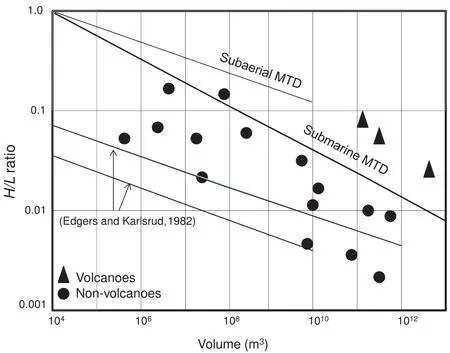
Figure 21 Plot of H/L (vertical fall height/length of runout) ratio versus volume of submarine MTD by Hampton et al. (1996). For comparison, the average value for subaerial MTD (upper curve) proposed by Scheidegger (1973) is shown. Note the upper?bound values from Edgers and Karlsrud (1982) for submarine (upper curve) and subaerial (lower curve) MTD. Redrawn from Hampton et al.(1996). With permission from American Geophysical Union.
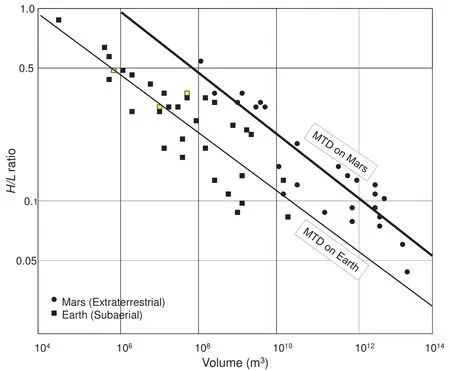
Figure 22 Plot of H/L (vertical fall height/length of runout) ratio vs. volume of MTD on Mars and Earth. Filled circles = Data points from Valles Marineris on Mars (McEwen, 1989, his Table 1). Filled squares = Data points for dry-rock avalanches of nonvolcanic origin on Earth (Scheidegger, 1973; Hsü, 1975). Lines are linear least-squares fits. Redrawn from McEwen (1989). With permission from Geological Society of America.
7) TheH/Lmodel has been applied to both ‘landslides’and ‘debris flows’ without acknowledging the basic differ?ences in sediment movement between the two processes(McEwen, 1989; Malin, 1992; Hamptonet al., 1996; Ab?lay and Hürlimann, 2000; McAdooet al., 2000; Elverh?iet al., 2002; Legros, 2002; Collins and Melosh, 2003;Geertsemaet al., 2009; Singeret al., 2012). The problem is that slides represent a rigid?body sliding motion over a shear surface (Varnes, 1978; Dott, 1963), whereas debris flows represent an intergranular flowing motion (Shan?mugamet al., 1994; Iversonet al., 1997).
8) In subaerial environments on Earth,H/Lratios were measured from outcrops (Heim, 1932), but in submarine environmentsH/Lratios were measured using bathymetric and/or side?scan sonar images (McAdooet al., 2000). On Mars,H/Lratios were measured from the Viking Orbiter images (McEwen, 1989). Clearly, there is no consistency among these methodologies.
9) Unlike on Earth, field measurements of motion type and direct examination of the rockin situare impractical in distinguishing slides from debris flows on other planets.Nevertheless, Malin (1992) interpreted slides and debris flows on Venus based on types of landforms seen on radar images acquired from the Magellan spacecraft. Costardet al.(2002) interpreted debris flows based on the observa?tion of small gullies on Mars, seen on images obtained from the Mars Observer Camera (MOC) aboard the Mars Global Surveyor spacecraft, and using the similarities of Martian gullies with gullies in East Greenland. Miyamotoet al.(2004) interpreted debris flows on Mars using MOC images and numerical simulation. The problem is that de?brite depositional facies should be interpreted using cm?scale primary sedimentary features in core or outcrop for establishing plastic rheology and laminar state of the de?bris flow (see ‘Recognition of Depositional Facies’ section above). Such detailed observations cannot be made using seismic data and radar images.
After over 130 years of research, since the work of Heim (1882), there is still no agreement on a unified scien?tific theory on long-runout MTD. The reason is that each case is unique. More importantly, there are no consisten?cies in concepts, nomenclatures, data sources, and meth?odologies when investigating MTD on different planets.
7 Reservoir characterization
An accurate depiction of depositional facies is crucial in reservoir characterization of deep?water MTD. However,there are cases in which the use of the term landslide has created unnecessary confusion. For example, Welbonet al.(2007, p. 49) state, “Landslides can consist of rotational slips,translational slide blocks,topples,talus slopes,debris flows,mudslides and compressional toes which com-bine in different proportions to form complex landslides…Processes of landslide deformation include slip on discrete surfaces,distribution of shear within the landslide,vertical thinning and lateral spreading through shear,fluidization,porosity collapse and loss of material from the top or toe of the complex.These processes control the quality of the resultant reservoirs.” This reservoir characterization raises the following fundamental questions:
· What are the criteria for distinguishing deposits of topples with no sliding motion from those of debris flows with flowing motion in core or on seismic profiles?
· Does the porosity collapse occurs in deposits of top?ples?
· If so, what are the criteria to recognize porosity col?lapse in deposits of topples in the subsurface?
· What is the point in including a landform (talus slope) along with a process (debris flow) under the term landslide? For clarity, reservoir characterization of deep?water sands must identify the process-specific depositional facies, such as slides, slumps, debrites,etc.
In reservoir characterization, wireline (e.g., gamma?ray)log motifs are the basic subsurface data that are routinely used by the petroleum industry. Interpreting a process?spe?cific depositional facies (e.g., slide vs. debrite) from a log motif, without corresponding sediment core, is impossi?ble. For example, analogous to sandy slide blocks that are sandwiched between deep?water mudstones in outcrops(Figure 11), long runout sandy debrite bodies (Figure 23)are likely to generate blocky motifs on wireline logs in the subsurface (Figure 24A). In distinguishing sandy slides(Figure 24B) from sandy debrites (Figure 24C) in the an?cient startigraphic record, direct examination of the rocks is crucial.
The other issue is the differences in reservoir quality between slides and debrites. Large sandy slides commonly contain multiple original strata (Figure 11). In cases where lithified strata are transported as sandy slides almost in?tact, the slided bodies are likely to represent original po?rosity and permeability (i.e., pre?transport reservoir qual?ity) from the provenance (Figure 24B). On the other hand,debrites are likely to represent post?transport depositional texture and reservoir quality (Figure 24C). Furthermore, if a sandy slide unit contains two sandstone reservoirs with an intervening shale layer, the shale layer could act as a permeability barrier (Figure 24B). In such cases, a single slide unit would have to be characterized as two separate petrophysical flow units. By contrast, a single debrite unit,without a permeability layer, would be characterized as a single petrophysical flow unit (Figure 24C).

Figure 23 Conceptual model showing long?runout sandy debrite blocks away from the shelf edge. Based on studies of sandy debris flows and their deposits in flume experiments (Shanmugam, 2000; Marr et al., 2001), documentation of long-runout sandy debris flows in modern oceans (Gee et al., 1999) and interpretation of long?runout ancient “olistolith” (Teale and Young, 1987). This model is useful in developing deep?water depositional models for sandstone reservoirs of debrite origin. After Shanmugam (2012a). With permission from Elsevier Copyright Clearance Center’s RightsLink: Licensee: G. Shanmugam. License Number: 3577110946798. License Date:February 27, 2015.

Figure 24 A-Hypothetical wireline log showing blocky motif for both sandy slide and sandy debrite units (compare with Figures 10A and 11). Blocky gamma ray (wireline) log motifs, among other motifs, are basic subsurface data that are routinely used by the pe?troleum industry (e.g. Shanmugam et al., 1995). The primary control of log motif is sediment texture (i.e., sand vs. mud), not individual primary sedimentary structures. Without direct examination of the rocks for sedimentary structures, distinguishing between a slide and a debrite facies is impossible from wireline log motifs alone; B-Hypothetical sedimentological log of a sandy slide unit, composed of three original layers representing pre?transport strata and texture from the provenance region, with basal shear surface and sand injec?tion. 1. Sandstone. 2. Shale. 3. Sandstone. Note that layer 2 (shale) may act as a permeability barrier and that layer 3 (upper sandstone)and layer 1 (lower sandstone) may behave as two separate flow units during production; C-Hypothetical sedimentological log of a sandy debrite unit with floating mudstone clasts and quartz granules (red circles). This debrite sandstone without permeability barrier would behave as a single flow unit. VF = Very fine sand; F = Fine sand; M = Medium sand.
8 Ending the problem
The term “l(fā)andslide” has been in use in a variety of scientific domains since 1838 without conceptual clarity.During the past 175 years, our failure to adopt a sound pro?cess-specific terminology has resulted in 79 superfluous MTD types in the geologic and engineering literature. This profligate period of “kicking the can down the road” must end now. Only slides, slumps, and debrites can be mean?ingfully interpreted in the sedimentary record. Therefore,the term “l(fā)andslide” should be restricted solely to MTD in which a sliding motion can be empirically determined. A precise interpretation of a depositional facies (e.g., sandy slide vs. sandy debrite) is vital not only for maintaining conceptual clarity but also for characterizing petroleum reservoirs. Clarity matters in science.
Acknowledgements
I thank Prof. Zeng?Zhao Feng (Editor?in?Chief) for his interest and Ms. Yuan Wang of theJournal of Palaeogeographyfor encouraging me to submit this review. I am grate?ful to the two anonymous journal reviewers for their criti?cal and helpful comments. This paper is the culmination of gathering and analyzing empirical data on MTD during the past 40 years. My sedimentological research on deep?water mass?transport deposits began in 1974 as a part of my Ph.D. work on the Middle Ordovician of the Southern Appalachians in the USA (Shanmugam, 1978; Shanmugam and Benedict, 1978; Shanmugam and Walker, 1978, 1980)and has continued through my employment with Mobil Oil Company (Shanmugam, 1996, 1997; Shanmugam and Moiola, 1995; Shanmugamet al., 1994, 1995) to the present as a consultant (Shanmugam, 2000, 2002, 2006a,2012a, 2013a, 2014a). I thank R. J. Moiola and other geo?logical managers for providing enthusiastic support for my research throughout my employment with Mobil (1978-2000). I am indebted to numerous colleagues at Mobil and other oil companies, petroleum?related service companies,academic institutions, and government agencies for as?sisting me in core and outcrop description worldwide. As always, I thank my wife Jean for her general comments.Finally, I am deeply indebted to Prof. Ian D. Somerville and Ms. Yuan Wang for their meticulous editing of this tome.
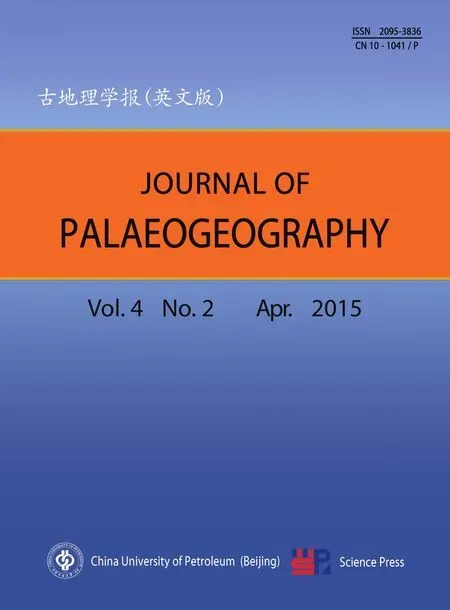 Journal of Palaeogeography2015年2期
Journal of Palaeogeography2015年2期
- Journal of Palaeogeography的其它文章
- Characterization and evolution of primary and secondary laterites in northwestern Bengal Basin,West Bengal, India
- Mesozoic basins and associated palaeogeographic evolution in North China
- Geodynamic evolution of the Earth over the Phanerozoic: Plate tectonic activity and palaeoclimatic indicators
- General regulations about submitting manuscripts to
- 2nd International Palaeo?geography Conference October 1013, 2015 Beijing, China First Circular
- Summary of the 1st Editorial Committee Meeting of Journal of Palaeogeography in 2015
